Works on paper from the 1960s
Exhibition from June 18 to July 24, 2020
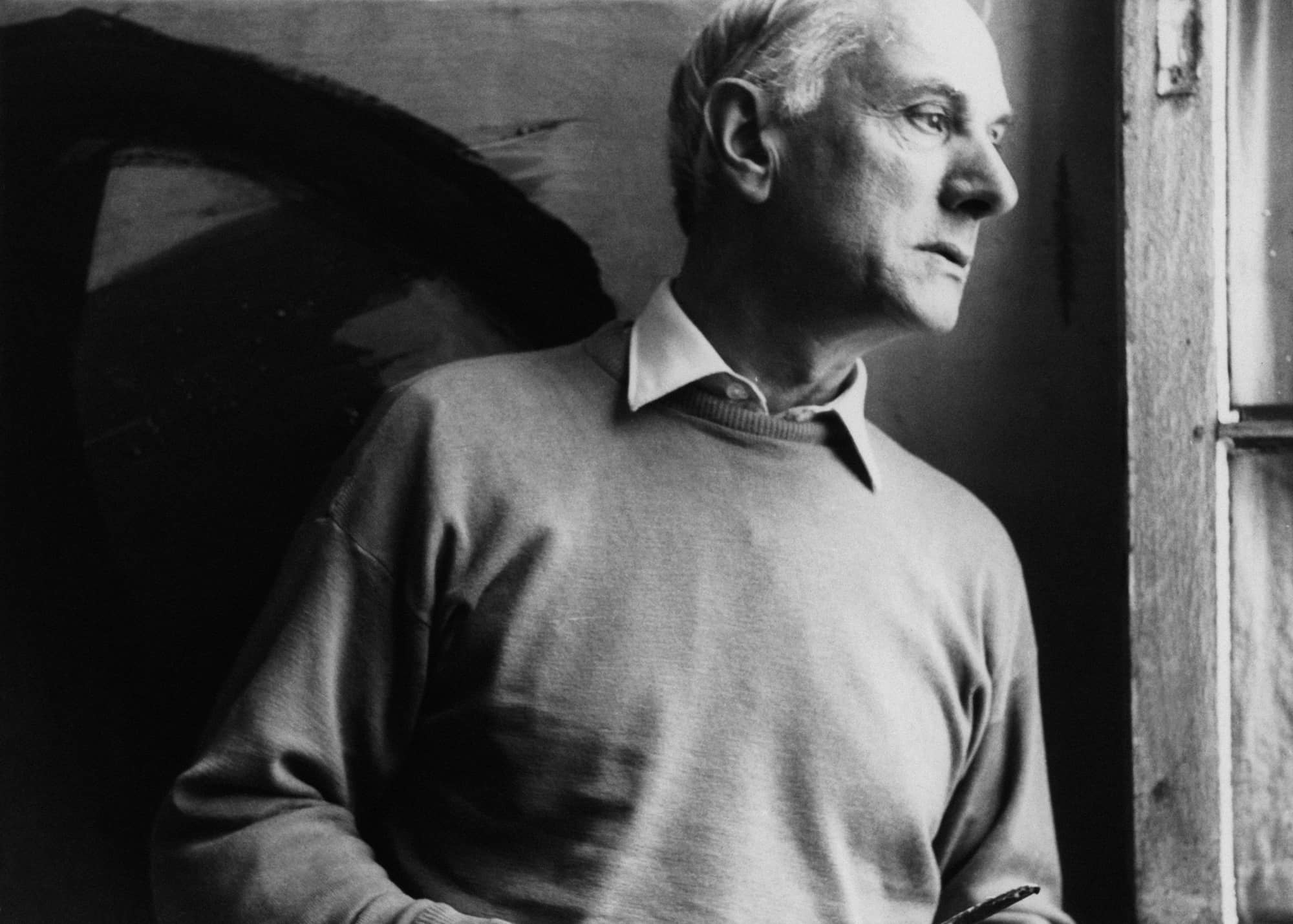
1 – Gérard Schneider in his workshop, rue Armand Moisant, Paris, France, around 1955
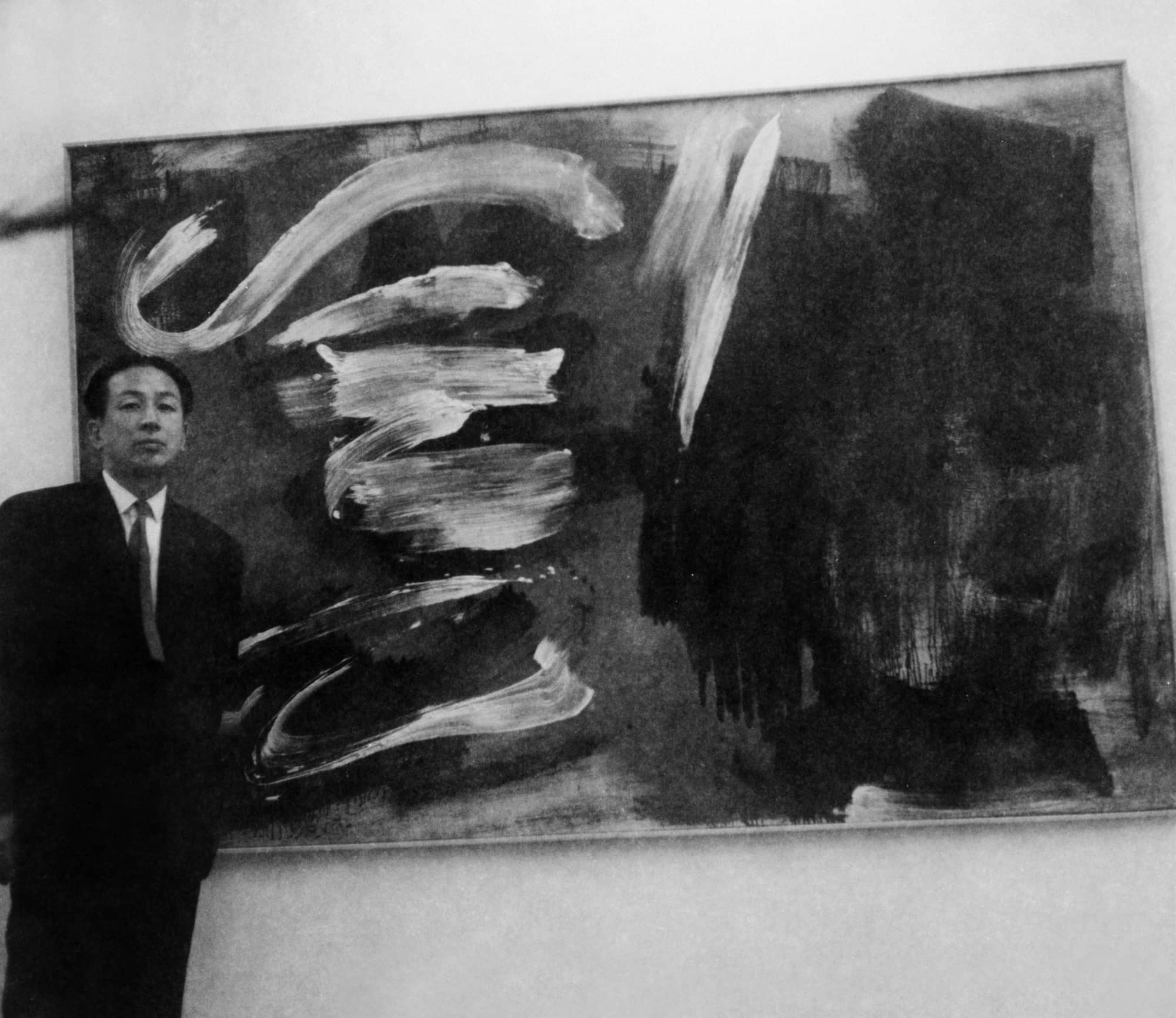
2 – Japanese artist Isami Hishida in front of Opus 20 F at the Salon de Mai in Japan exhibition, Osaka, Japan (Oct. 1962)
Starting with two exhibitions in Japan in 1960 [notes – galleries and dates]1 and ending with the major retrospective in Turin in 1970, the 1960s were for Gérard Schneider a crucial period.
After starting in Paris as a founder member of Lyrical Abstraction alongside Hans Hartung and Pierre Soulages, followed by an American career brilliantly orchestrated by the New York gallery Samuel Kootz, the 1960s confirmed the international range of Gérard Schneider’s work. His participation in the São Paulo Biennale in 1961, where he showed large format paintings, the very important retrospective shown in Düsseldorf and then in Brussels in 1961, the Venice Biennale in 1966 where an entire room was devoted to his art2 , and his inclusion in the exhibition Painting in France 1900-1967 which was held in seven prestigious North American museums during 1968 underline this. The many exhibitions held in Italy which established Schneider in the artistic landscape of that country should also be mentioned. Finally, to appreciate fully the scope and great interest during the 1960s for Gérard Schneider’s painting, an exhibition in Switzerland in 1961 (the first since 1920), the many times he showed at the Tokyo Biennale, the May Salon in Cuba in 1967, exhibitions in South America and North Africa are noteworthy.
This list, which is not exhaustive, confirms that his work featured prominently at the key art events of those years of major change. Gérard Schneider was included in these as a major personality of European abstract art.
The 1960s were important for Gérard Schneider but also for the history of art itself. This was a time when abstract art was questioned by New Realism and Pop Art, and coincided with New York being confirmed as the new capital of the arts: Robert Rauschenberg won the Grand Prize of the Venice Biennale in 1964. The questions raised by these radical changes made the position of European abstract artists fragile, and more generally the European art world. These years were synonymous with major upheavals in relation to how art should be “produced”, and displayed and also how artistic practices were considered.
In this context, Schneider found a specific place and lived through the 1960s not wanting to “stick” to the new demands of this period, but to continue a very personal path, the bases of which had been established about thirty years earlier.
From then the object of all his attention was colour.
Schneider had always been a great colourist but it was only at the dawn of the 1960s that this aspect of his work was revealed with force and clarity. From the initial discovery of abstraction at the end of the 1930s to the exploration of the form, then of gesture imprinting life on the form, he was now certain he was in a position to accomplish a sort of liberation of colour.
Colour became form and form colour, as Michel Ragon very rightly says3.
In 1967, Gérard Schneider stated that:
“It seemed impossible to me, in the search for a new expression, to juggle the invention of the form and the invention of its colour, as giving thought to only one of these requires attention. My studies showed me that problems of form should be resolved first (more complex) with those of colour being dealt with afterwards, and lastly the definitive solution is to be sought for the fusion of these two elements that become complementary”4.
This fusion to which Schneider refers works, yet again, through the gesture. This gesture was initiated at the start of the 1950s and slowly became more and more significant, abandoning its expressionist character to take on a calligraphic dimension, which became omnipresent during the 1960s.
This “liberation” was a major development in Gérard Schneider’s work and led him to produce works which, on first impressions appear to be a complete break away from the works produced during the previous decade.
Nevertheless in Schneider there are no complete breaks or about turns. Rather, there are intensifications of the artistic act. What his painting gained in greater sensory and semantic depth, it lost in mineral and powerful material. It gained then in depth and light. The impetus in this transformation is colour. It is colour alone that from then on constructed, gave structure, built and illuminated. Colour as a perfect mirror of the creative psychism.
The dynamic of this trilogy: form, gesture, colour, reaches a real maturity in the second half of the 1960s. The works that were exhibited provoke a visual shock that is both aesthetic and sensitive in the viewer. The surprise is real and some of the painter’s supporters were even destabilized by such risk taking. This was the case for his long standing friend Ludovic Massé. In a letter, Gérard Schneider replied to him very aptly: “In this way […] do you have to ask for a large amount of confidence? No, not even, but quite simply to abandon yourself yet again to an emotion, a sensation, something that, beyond concepts, means that although art can change appearance, it remains fundamentally the same.”5
After 1967-1968, a purely technical relationship profoundly changed his way of working: the adoption of acrylic paint. Now available in Europe, this new medium allowed him to implement his compelling desire to give colour a leading role. Even if at the start it was limited to the creation of backgrounds (both for paintings on canvas and works on paper), very quickly, acrylic became his exclusive medium, as if how quickly it dries, and therefore the speed of execution of a piece, finally enabled him to construct the colour space with the same ease and spontaneity as the gesture allowed materialization of rhythms and signs on the painted surface.
The time of a work for Gérard Schneider does not fit into the time of history but into that of personal study. There is of course an identifiable evolution in the work overall, but there are also “constants”, recurrences.
Recurrences of forms, signs and colours.
It was during the 1960s that all the components seem to organize and be structured in compositions imprinted with plenitude and power. Completeness of the composition, balanced, rhythmed, “essential” and power of the chromatic impact. Power of a soothed and precise gesture, infinitely free, poetic too.
It is with paper as a support that Gérard Schneider perhaps demonstrates most subtly the balance between the light and the powerful, between the obvious and the implied – a mastery of the full and empty, a “calligraphy of colour”6. The fragility of paper is confronted with the power of the artist’s gesture. The surface of the sheet receives this intense and violent colour yet everything seems to be organized and structured in the most natural way.
The works on paper exhibited at the Galerie Diane de Polignac is a perfect presentation of this profound and necessary evolution in Schneider’s work during the 1960s. From the heritage of the 1950s to the powerful and colourful compositions, the path along which Schneider guides us is a series of wonders, surprises, of moments of pure contemplation and also of invitations for us to wonder what the very essence of painting is.
The power of these works on paper is to provide the keys to better appreciate our comprehension of what abstract art is and how it participates in our perception of the real. It is also a way of showing us an exemplary path, without compromise, without abnegation, in the lineage of the major figures of 20th century art.
Christian Demare, June 2020
1 – Minami Gallery, 8–20 Aug. 1960, Tokyo and Nakanoshima Gallery, 26 Sept.–8 Oct. 1960, Osaka.
2 – Annick Spay, Laurence Waurin, La France à Venise, le pavillon français de 1948 à 1988, exh. cat., Venice, Peggy Guggenheim Foundation (23 May–30 Sept. 1990), Venice, Paris, Rome: Peggy Guggenheim Fondation, Association Française d’Action Artistique, Carte Segrete, 1990.
3 – Michel Ragon, Schneider, Angers: Expressions contemporaines, 1998.
4 – Marcel Brion, Roger van Gindertael, Schneider, Venice: Alfieri, 1967
5 – Cited by Michel Ragon in Schneider, Angers: Expressions contemporaines, 1998
6 – It should be noted that although Gérard Schneider admired Japanese calligraphy (the many Japanese calligraphy magazines that Gérard Schneider owned proves this), his exhibitions in Japan, the interest of prestigious art critics, the articles on Schneider in Japanese magazines and visits to Schneider’s studio by Japanese artists travelling in Europe, indicate that Gérard Schneider’s was not at all foreign to the emancipation of many Japanese artists during the 1950s and the 1960s.

3 – Poster of the 33rd Venice Biennale, Venice, Italy, 1966

4 – Invitation to the opening of the Gérard Schneider exhibition, Galleria Civica d’arte moderna, April 16, 1970

5 – Schneider monograph by Michel Ragon, Amriswill, Bodensee Verlag, 1961

6 – Catalog of the exhibition Gérard Schneider, Galleria Martano Due, Turin (Dec. 1968)

7 – Schneider monograph by Marcel Brion and Roger van Gindertael, Venice, Alfieri, 1967
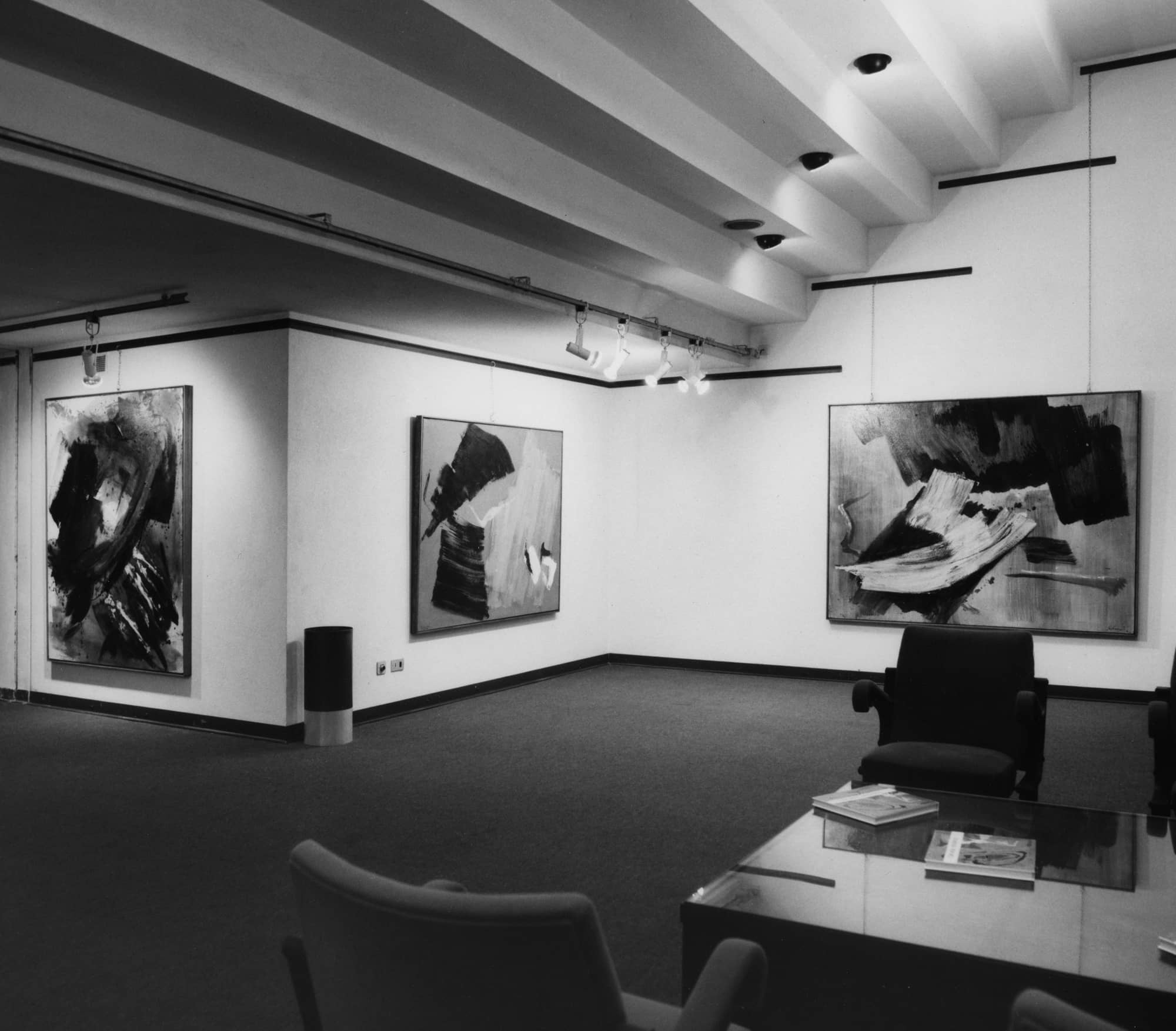
8 – View of the Gérard Schneider exhibition, Galleria San Fedele, Milan, Italy, (Oct. 1968)

9 – Gérard Schneider at the opening of the Gérard Schneider retrospective exhibition, Galleria civica d´Arte moderna, Turin, Italy, (Apr. 16 – May 24, 1970)
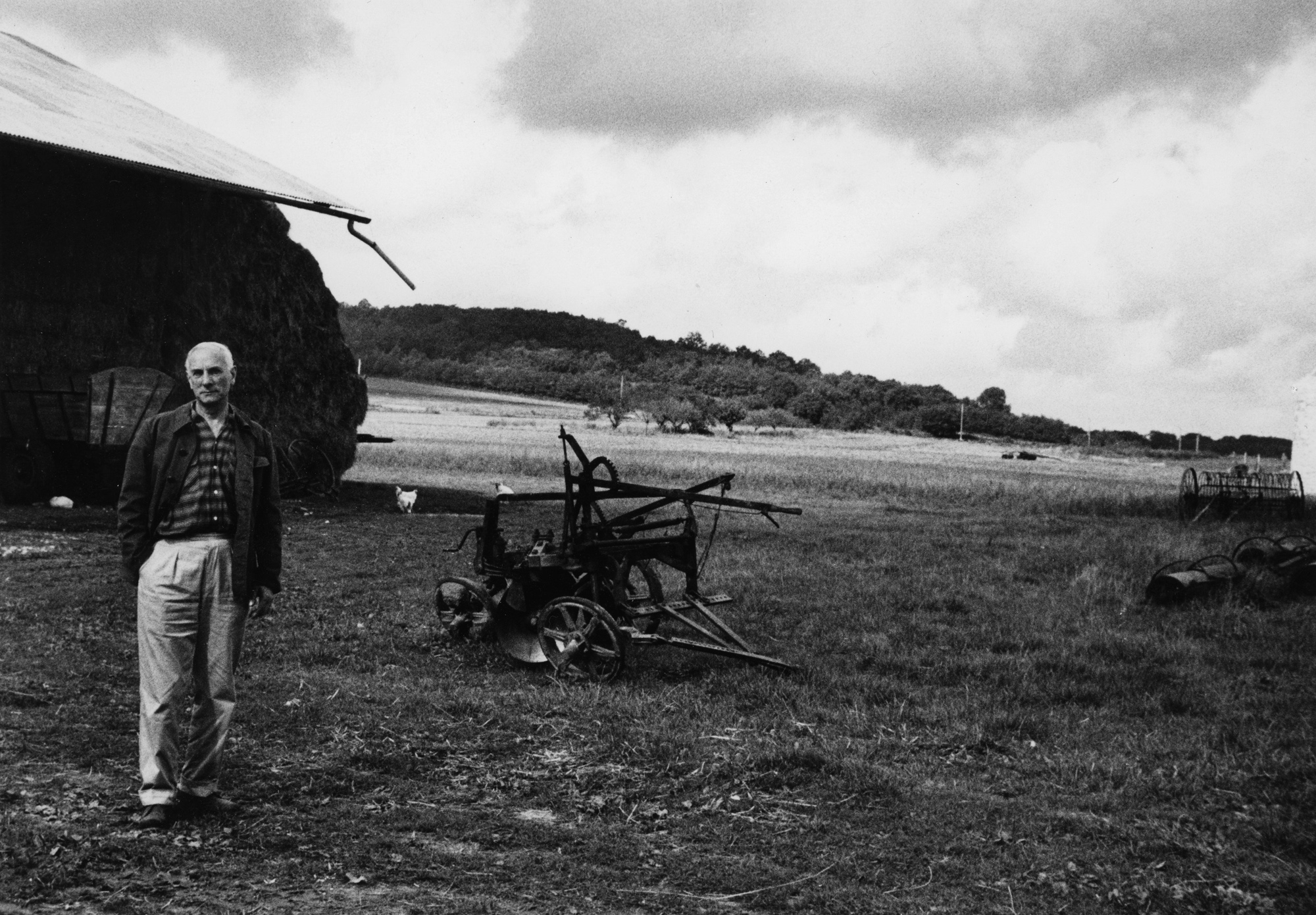
10 – Gérard Schneider photographed by Michel Ragon, Les Audigers, Sept. 1960

11 – Cover of the catalog for the Gérard Schneider retrospective exhibition, Brussels, Palais des Beaux-Arts (June 1962)
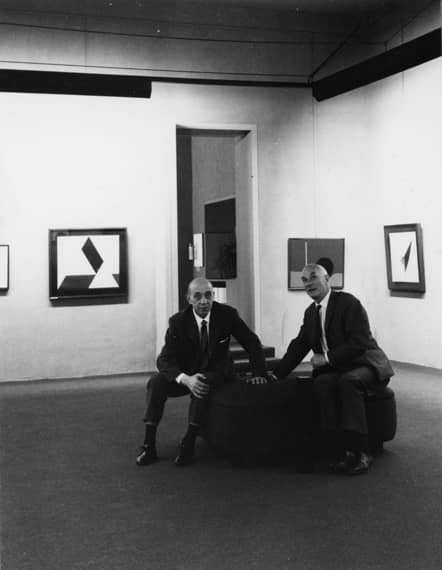
12 – Arturo Bonfanti and Gérard Schneider visiting the Arturo Bonfanti exhibition, Galleria Lorenzelli, Bergamo, Italy, 1966
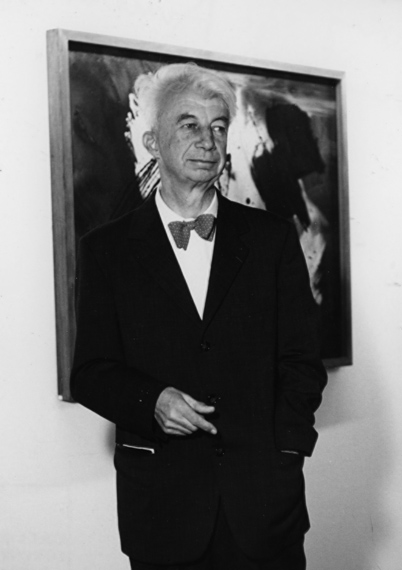
13 – Willem Sandberg, director of the Stedelijk Museum in Amsterdam, visiting an exhibition by Gérard Schneider, Italy, around 1965
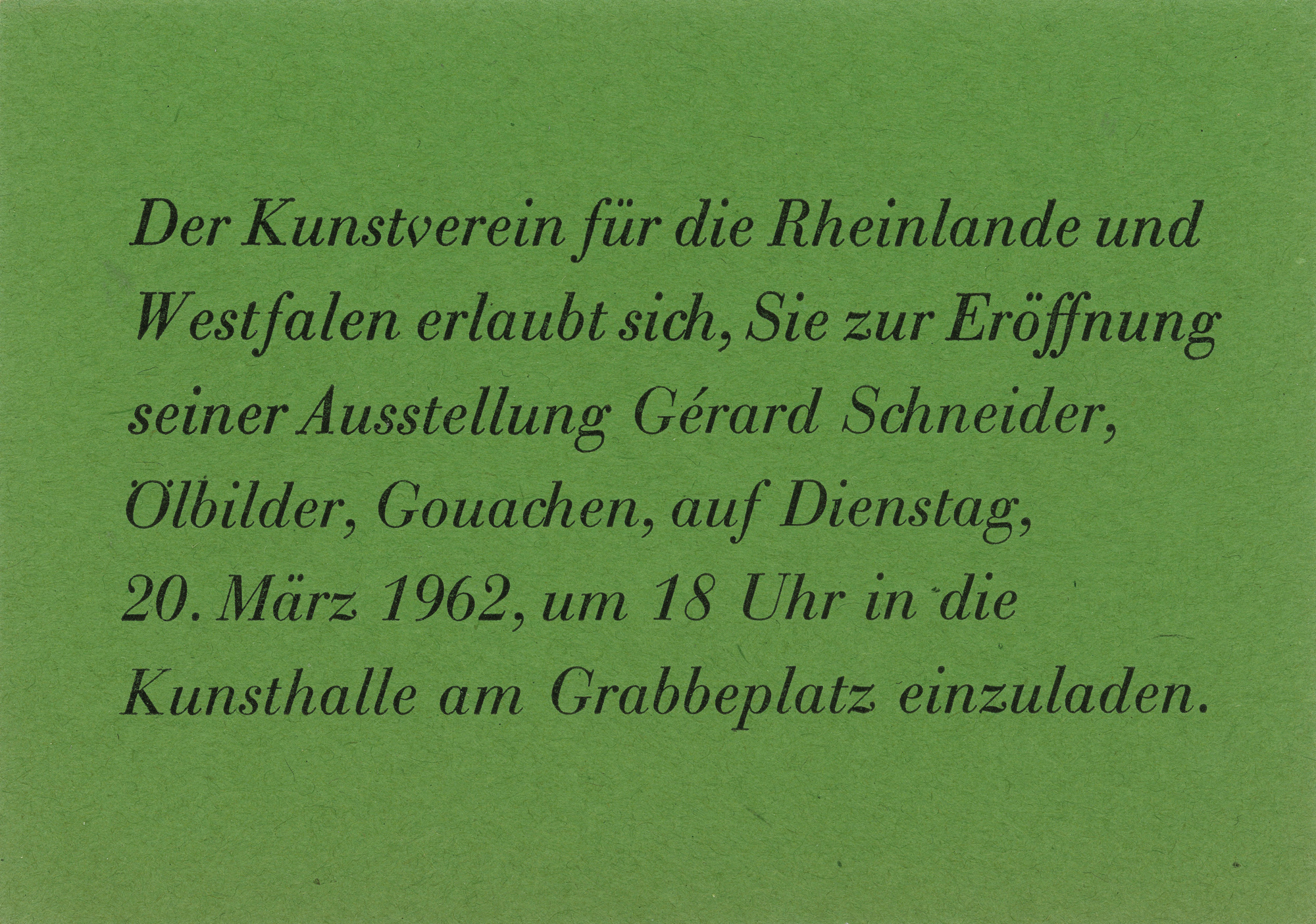
14 – Invitation card to the Gérard Schneider retrospective exhibition, Kunstverein, Düsseldorf, Germany (March 20 – Apr. 23, 1962)

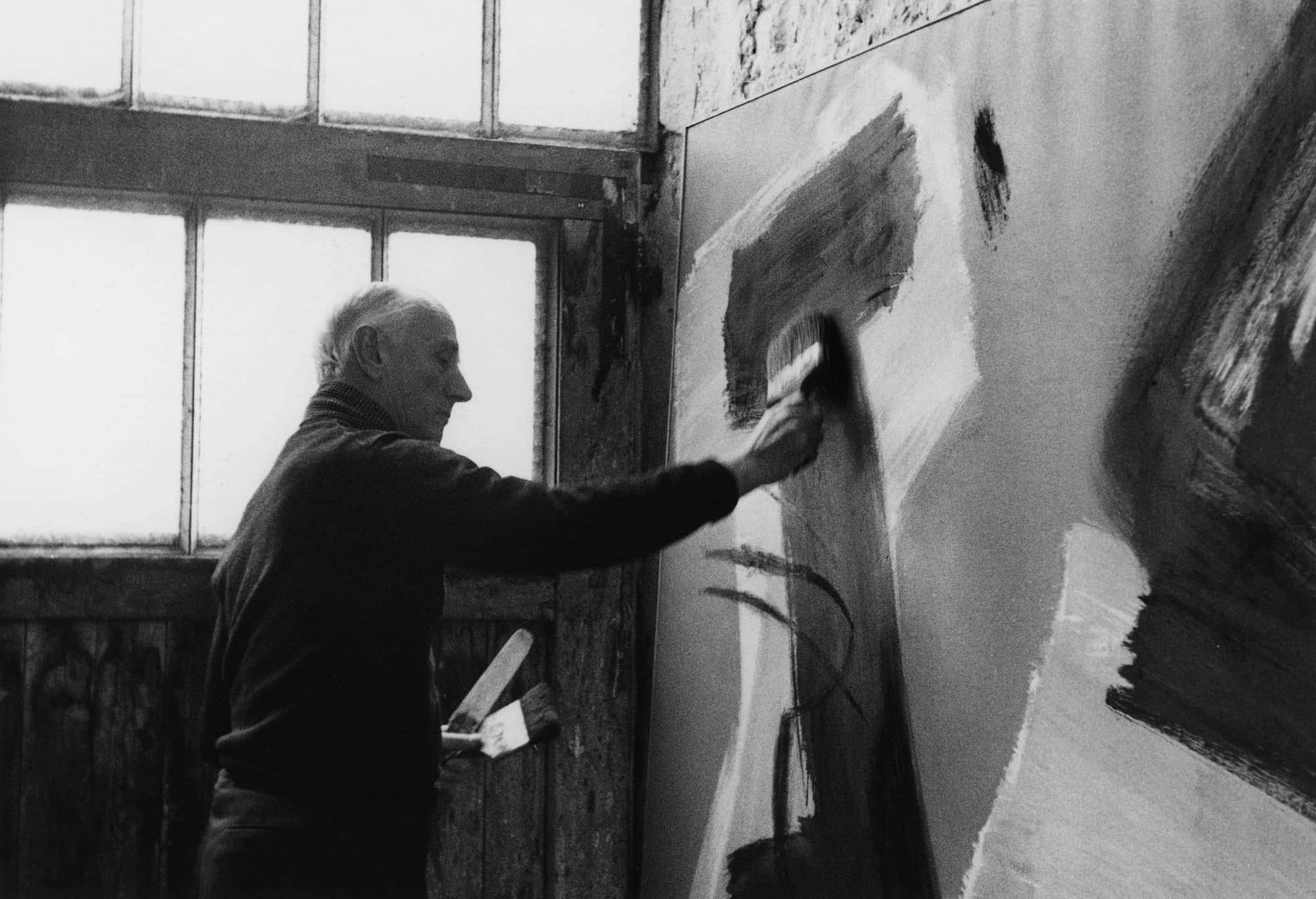
15 – Gérard Schneider in his studio painting Opus 15 i, Les Audigers, 1967

16 – Article presenting works by Gérard Schneider, Hans Hartung and Pierre Soulages in the review Bokubi n°82 (1959)
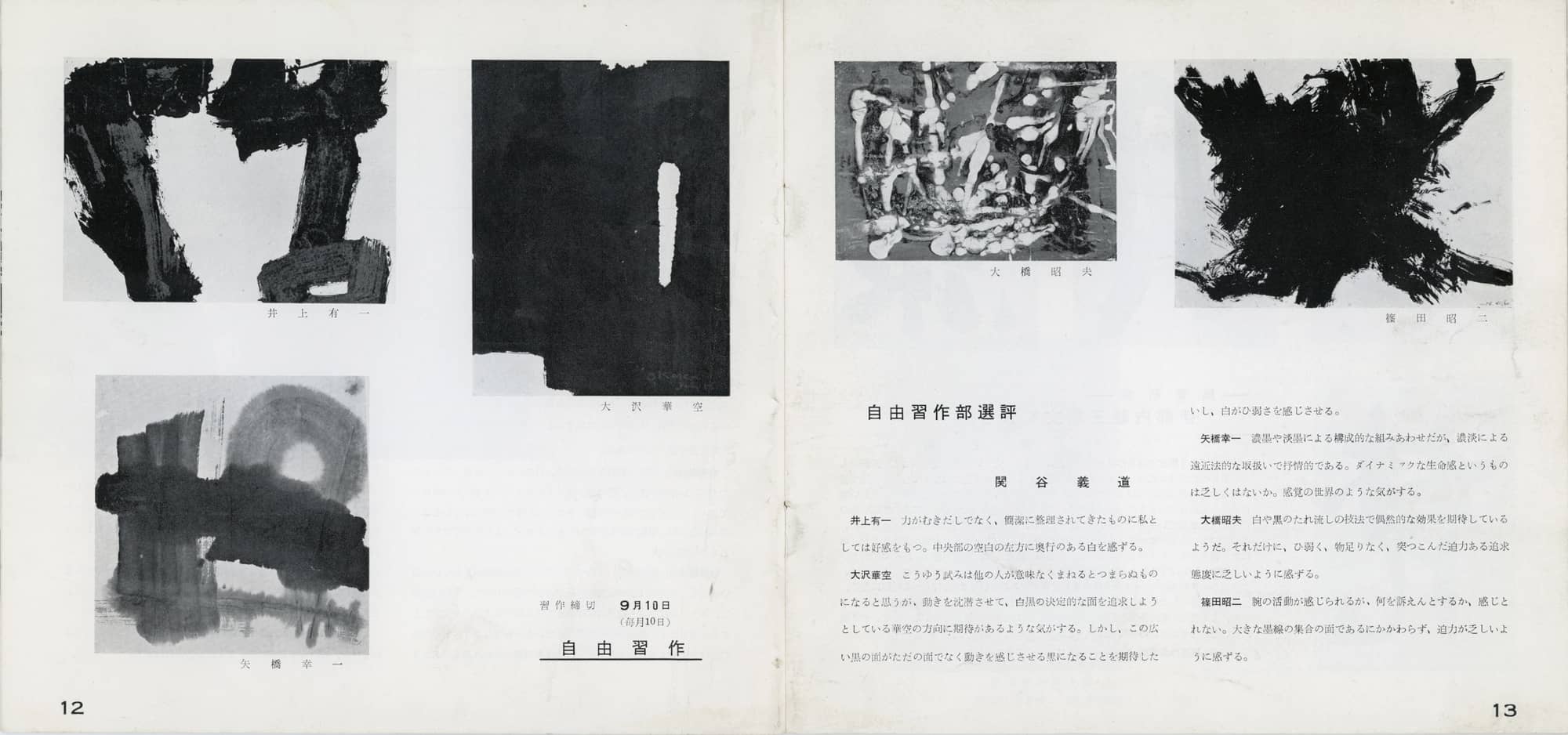
17 – Works of young Japanese artists, Bokuzin n°47, 1956
EXHIBITED WORKS
Texts by Astrid de Monteverde


Gérard SCHNEIDER
Untitled – 1961
Gouache, India ink and pastel on paper
21 x 27 cm / 8 1/4 x 10 5/8 in.
Signed and dated “Schneider / – 61” lower right
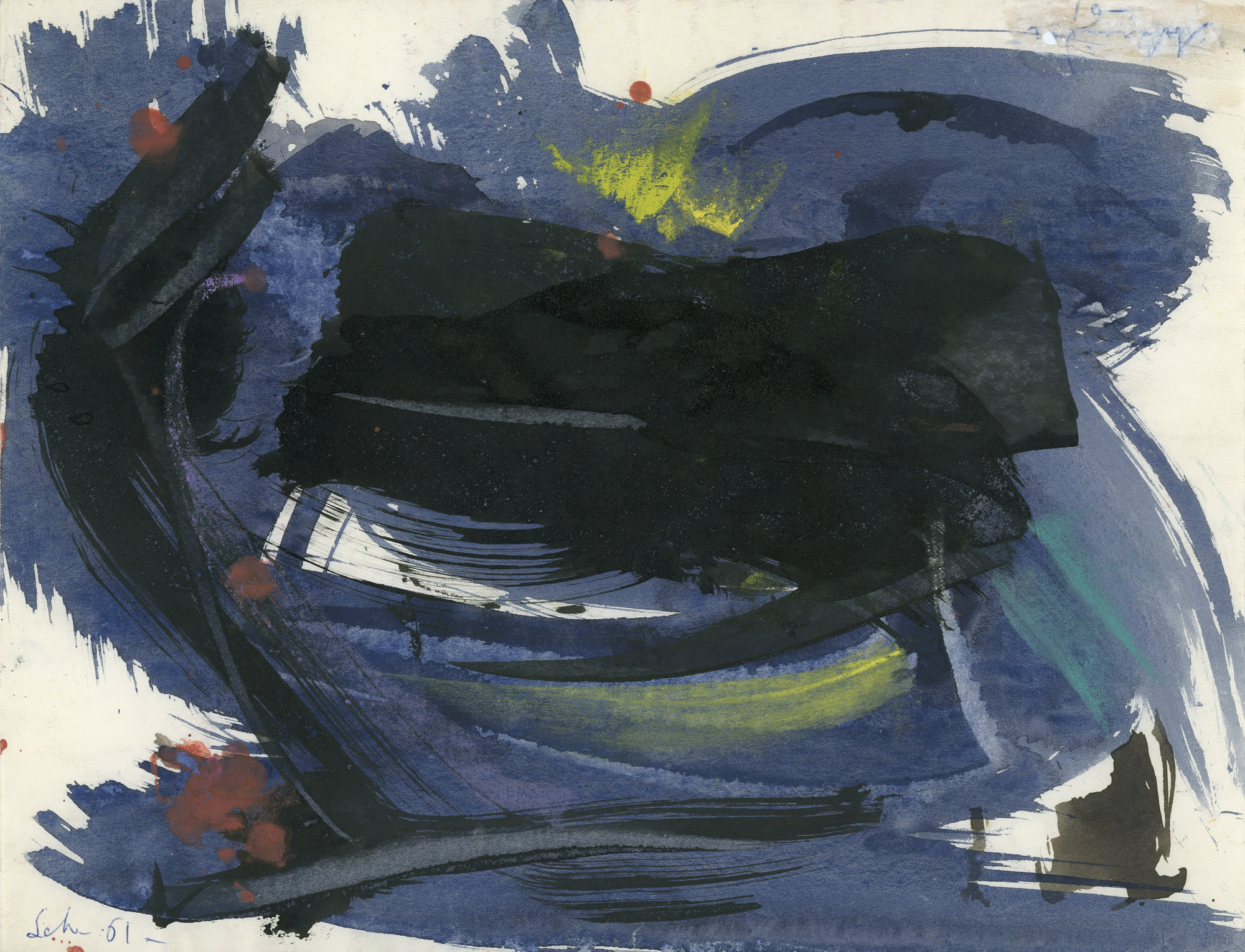
Gérard SCHNEIDER
Untitled – 1961
Gouache, India ink and pastel on paper
21 x 27 cm / 8 1/4 x 10 5/8 in.
Signed and dated “Schneider .61 –” lower left

Gérard SCHNEIDER
Untitled – 1961
Gouache, India ink and pastel on paper
21 x 27 cm / 8 1/4 x 10 5/8 in.
Signed and dated “Schneider / – 61” lower right
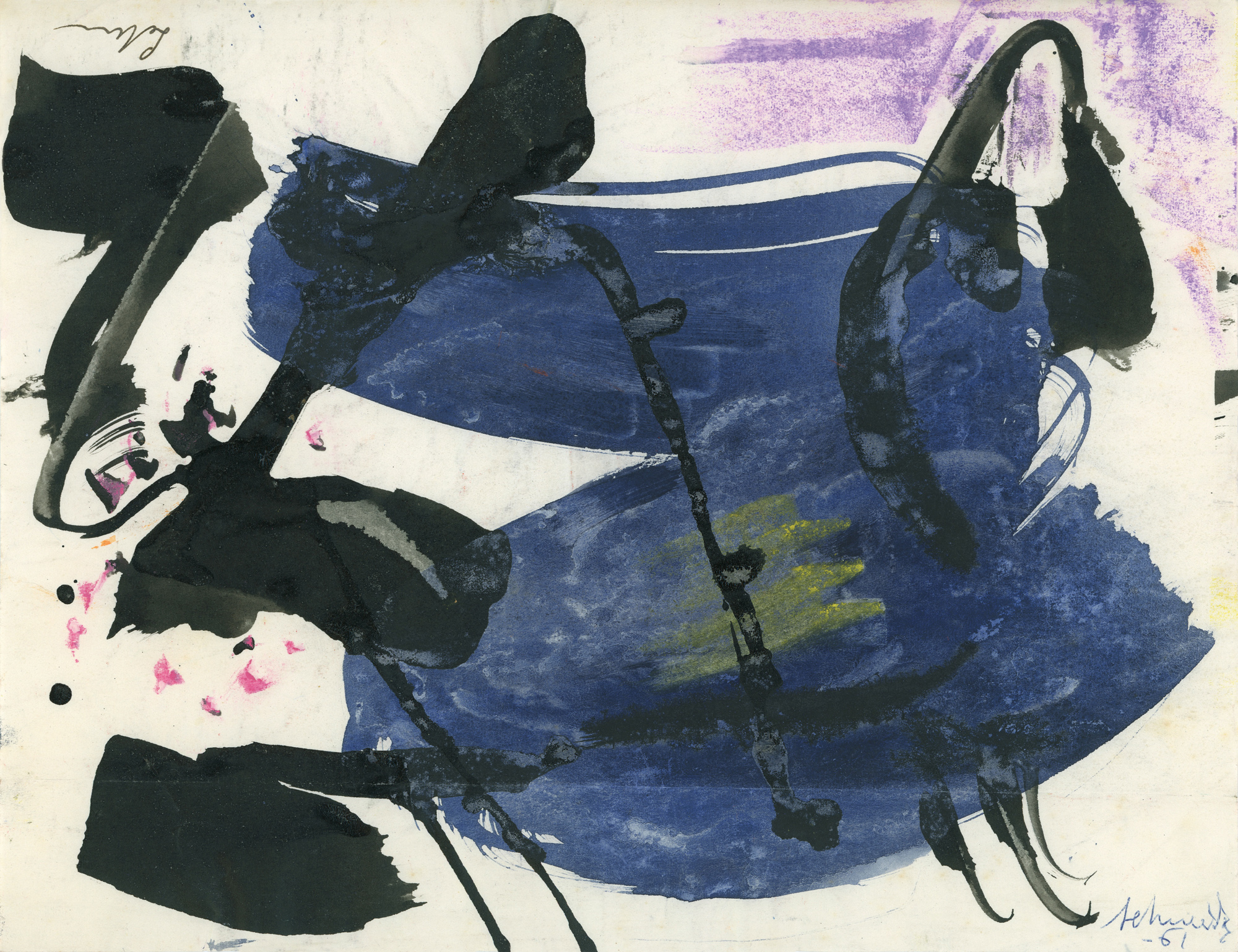
Gérard SCHNEIDER
Untitled – 1961
Gouache, India ink and pastel on paper
21 x 27 cm / 8 1/4 x 10 5/8 in.
Signed and dated “Schneider / – 61” lower right
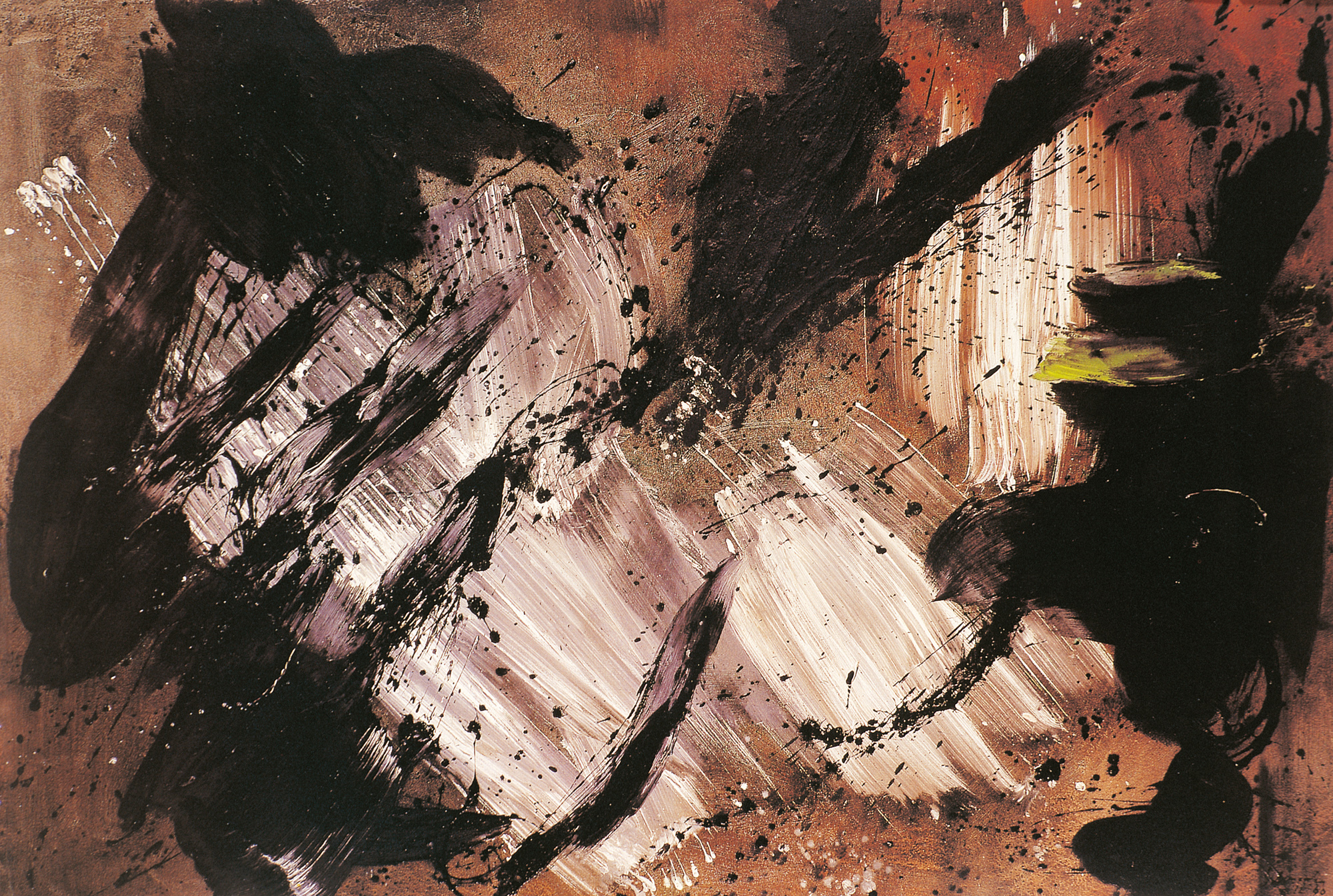
Gérard Schneider
Opus 68 E – 1960
Oil on canvas, 150 x 220 cm
Museum of Fine Arts,
Seoul, South Corea

repr. p. 13

repr. p. 14

repr. p. 15

repr. p. 16
At the start of the 1960s, Schneider’s work became brighter. After the nervous compositions with their telluric and volcanic colours of the late 1950s, paintings appeared in which white became the structuring element. This colour marks a breath, a call to a gap of light that springs from the background. The gesture is still intense but the atmosphere has settled, becoming more romantic and dreamlike. These compositions are marked by blended colours, by a black brush that creates rhythm in a dance on the canvas. Schneider, then living in his studio-home at Les Audigers in the Essonne, also added sand, collected around Fontainebleau, to the support. This gives a matt appearance to the surface and absorbs the colour to make it more diffuse.
For Schneider, paper was a support in its own right. He did not use it to make preparatory studies for painting on canvas, but as a specific field of exploration. It was of a form of creation parallel to his production of paintings on canvas. Paper gave Schneider greater freedom of action. Less expensive, paper allowed him to be more audacious. He was interested in the play of different media: ink, gouache, pastel. Paper also made the creative gesture livelier: the trace of the brush can be appreciated, the nervousness of a gesture, even drips from the brush formed by his momentum while producing. Colour brought by pastel comes as a final touch to support the form, to give it rhythm, to highlight it and to make it lighter. It supports the gesture. A counterpoint.

Gérard SCHNEIDER
Untitled – 1962
Gouache and pastel on paper mounted on cardboard
37,3 x 51,7 cm / 14 11/16 x 20 3/8 in.
Signed and dated “g. Schneider 62” lower left
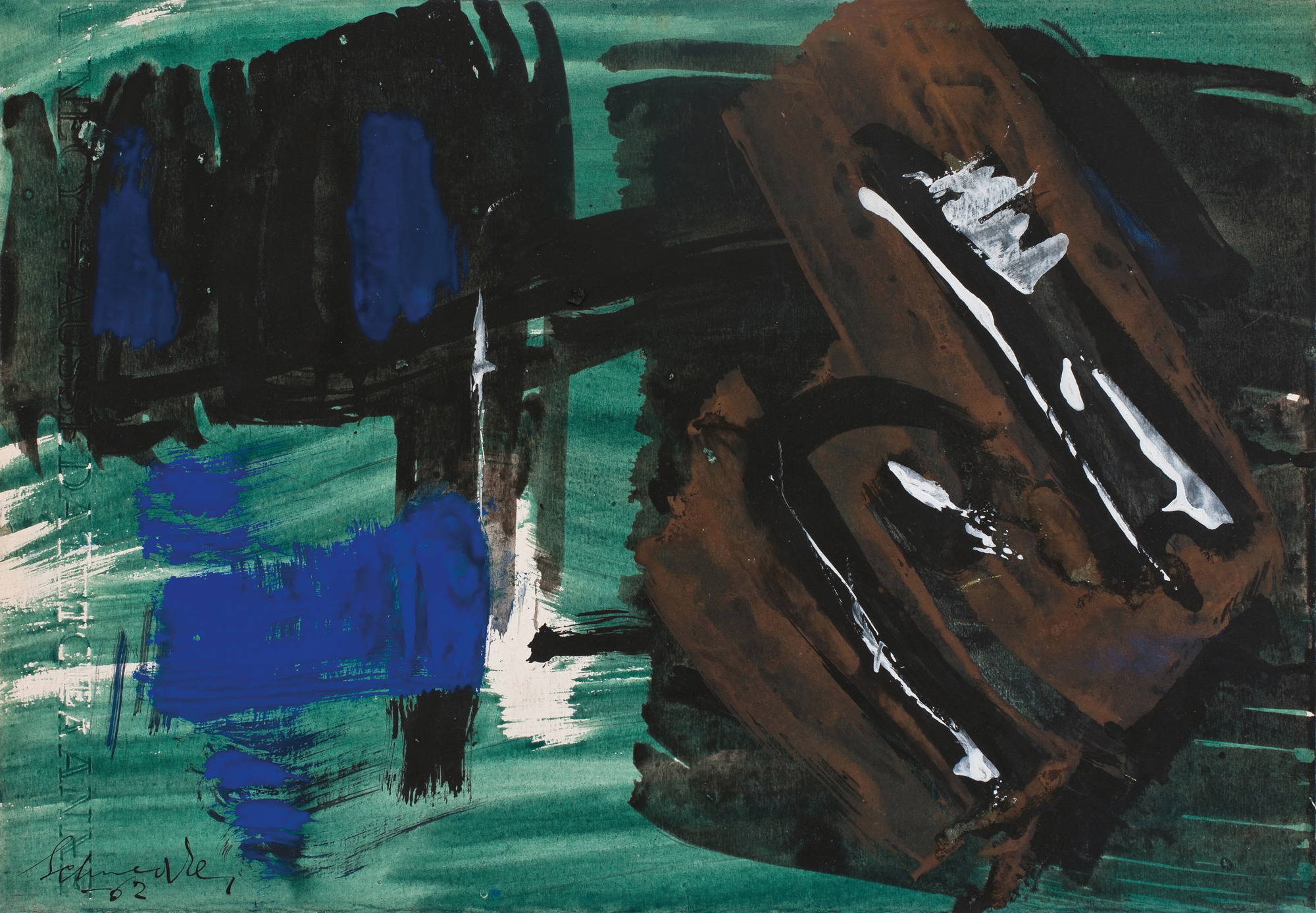
Gérard SCHNEIDER
Untitled – 1962
Gouache and India ink on paper
25,8 x 37,4 cm / 10 3/16 x 14 3/4 in.
Signed and dated “Schneider / –62” lower left
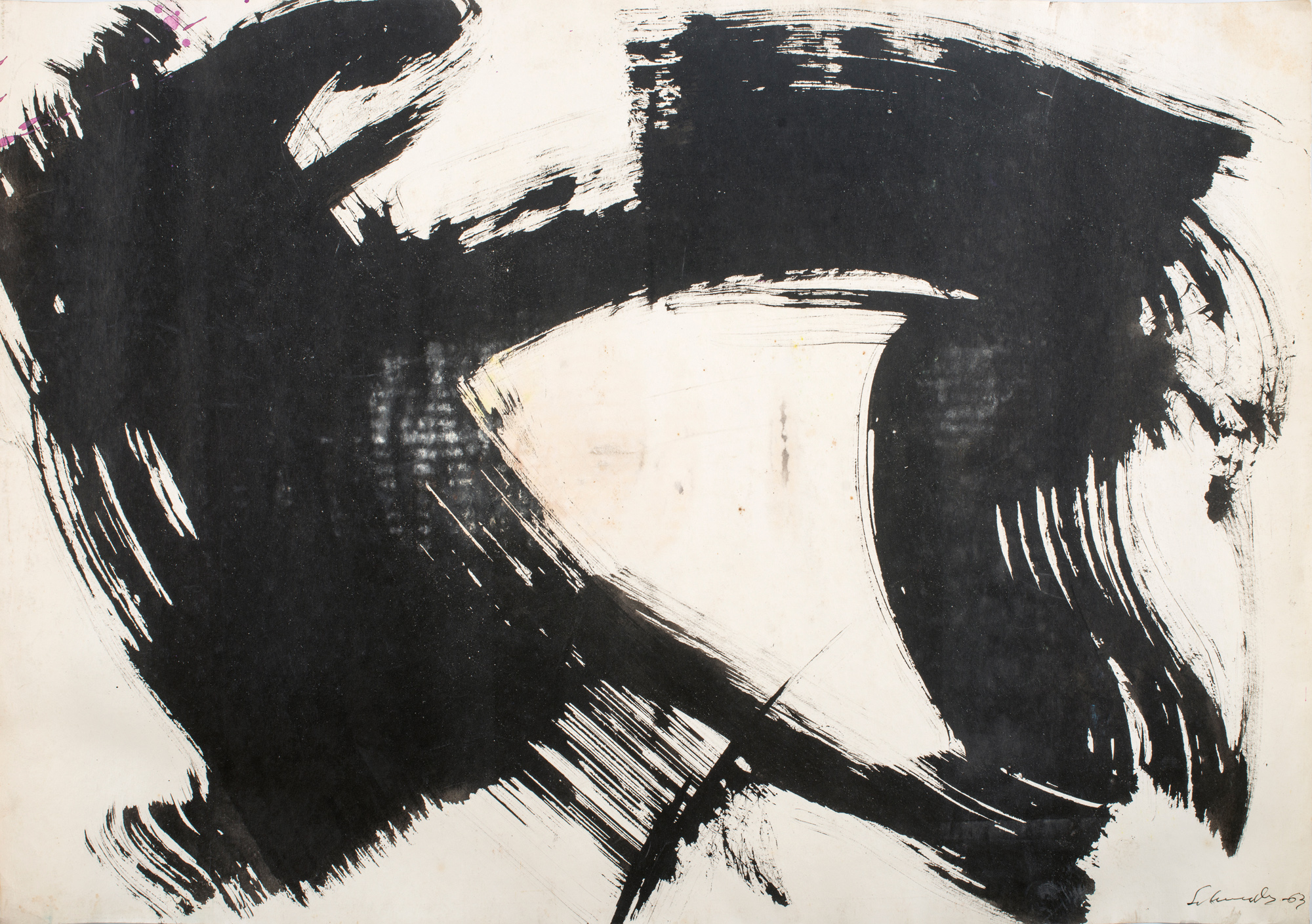
Gérard SCHNEIDER
Untitled – 1963
India ink on paper mounted on cardboard
52 x 74,5 cm / 20 1/2 x 29 5/16 in.
Signed and dated “Schneider –63” lower right

Gérard SCHNEIDER
Untitled – 1964
Gouache on paper
20,2 x 36 cm / 7 15/16 x 14 3/16 in.
Signed and dated “Schneider / –64” lower right

Gérard SCHNEIDER
Untitled – 1964
Gouache and India ink on paper mounted on cardboard
34,3 x 50,5 cm / 13 1/2 x 19 7/8 in.
Signed and dated “Schneider / 64” lower left
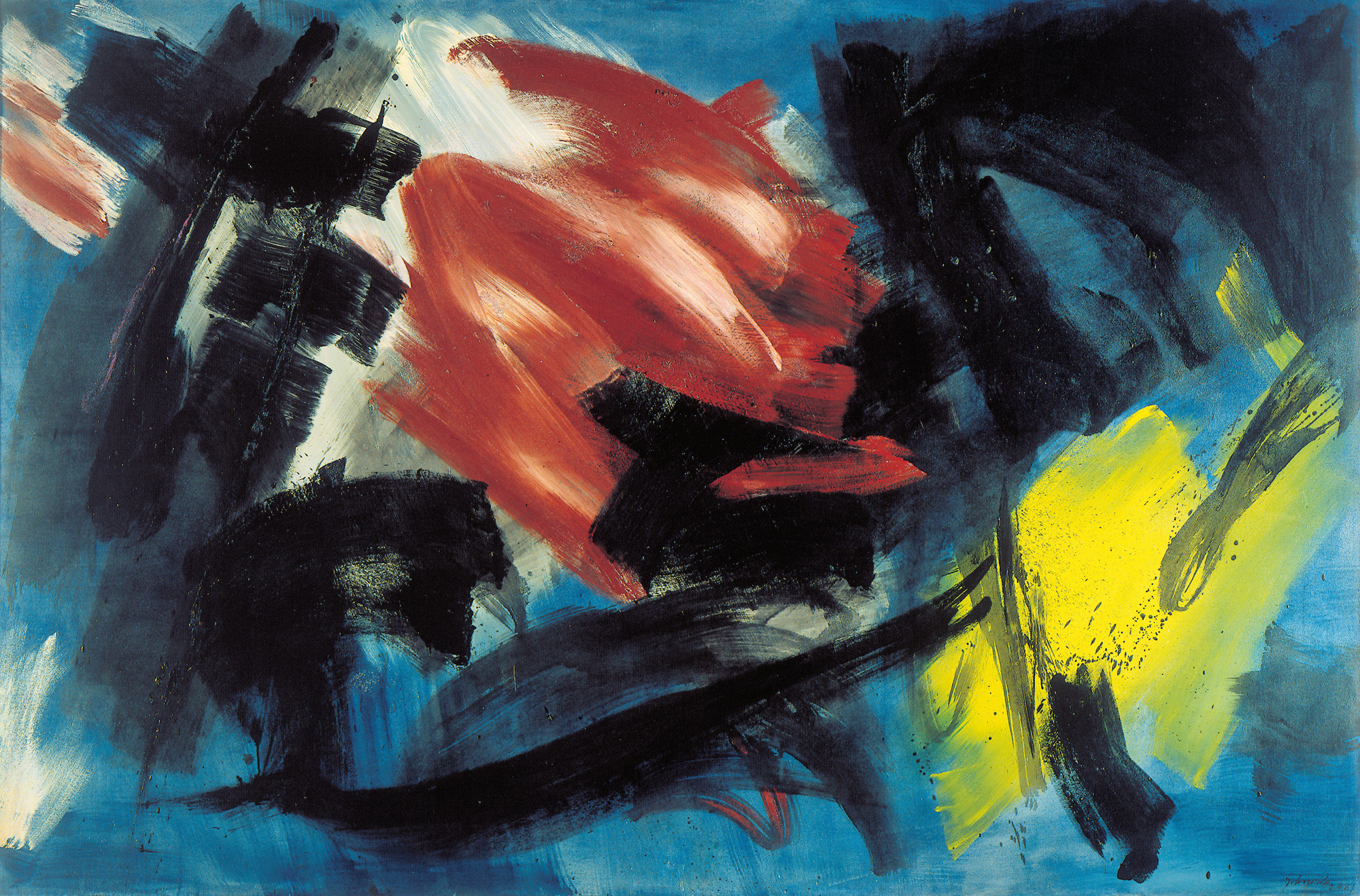
Gérard Schneider
Opus 95 E, 1961
Oil on canvas, 200 x 300 cm
Musée national d’Art moderne, Paris, France

Gérard Schneider
Untitled, 1965
Gouache on paper, 43 x 54,5 cm
Private collection, France
As a thinker about the history of art, Schneider had become interested in colour during the 1940s. Initially he had been fascinated by form, then he integrated the gesture in his process. In the early 1960s, he turned naturally towards the exploration of colour. This interacted with the overall work. It invited dialogue. For Schneider, who loved music, one could say that his work transforms into a symphony of tones and shapes. The backgrounds that were at first dense allow the light to come through. Then gradually, they became uniform.
In this composition of 1964, three primary colours give structure to the composition. Gouache gives a certain matt appearance to the work, but does not prevent light from emanating from the background. The gesture, materialized by the ink, makes the composition dynamic by drawing from a reservoir of forms specific to Schneider: curves and arcs, double streaks too.
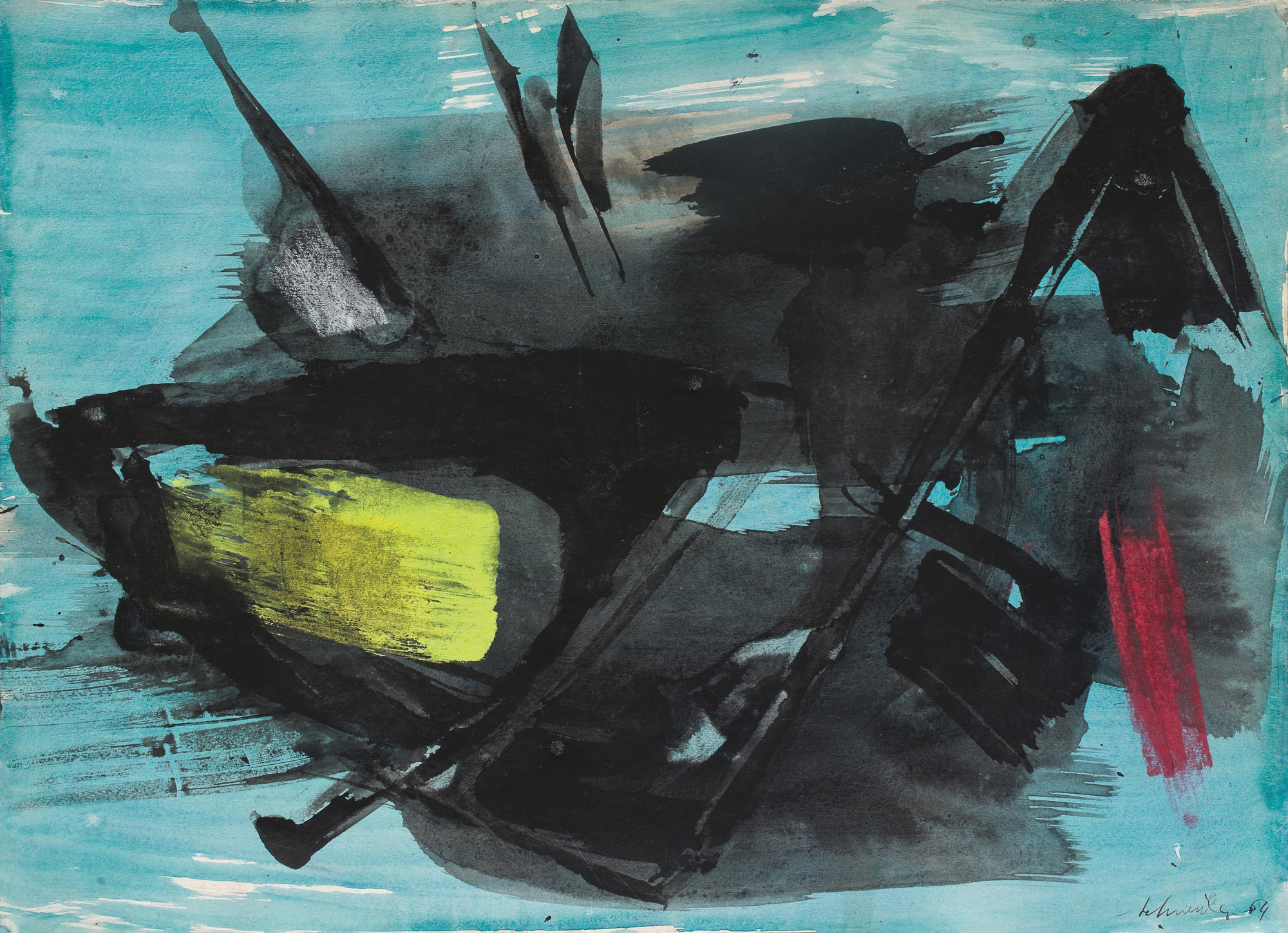
Gérard SCHNEIDER
Untitled – 1964
Gouache, India ink and pastel on paper mounted on cardboard
37,2 x 52,4 cm / 14 5/8 x 20 5/8 in.
Signed and dated “Schneider–64” lower right

Gérard SCHNEIDER
Untitled – 1964 ca.
Gouache and India ink on paper mounted on cardboard
26,1 x 37,3 cm / 10 1/4 x 14 11/16 in.
Non signed, non dated

Gérard SCHNEIDER
Untitled – 1967
Gouache, India ink and pastel on paper
105 x 75 cm / 41 5/16 x 29 1/2 in.
Signed and dated “– 67 Schneider” lower right
Schneider’s ink work on paper marks clear bridges between the technique and the Japanese gesture. During the 1960s, his work was exhibited in Japan among other locations: from 1953 to 1965, Schneider exhibited without interruption at the International Art exposition in Tokyo. Two solo exhibitions of his work were organized in Japan during the 1960s, at the Minami Gallery in Tokyo and at the Nakanoshima Gallery in Osaka. He also participated in the 1962 May Salon in Tokyo and Osaka. His works were also reproduced regularly in the art journal Bokubi. Schneider’s work was especially appreciated in the land of the Rising Sun. From the 1960s, Schneider’s gesture became reminiscent of a calligraphic gesture. The gesture was refined and became significant. Ink allowed him to play on shades of black, on his variations: blacks that were intense, light, brilliant, shimmering, blueish…
In this composition from 1967, the broad shape in ink rests on a wide red brushstroke on the left. In the momentum of the creative gesture, the paint has dripped from the brush, creating a network of marks that punctuate the background left in reserve. The highlight in green pastel in the centre makes the composition dynamic.
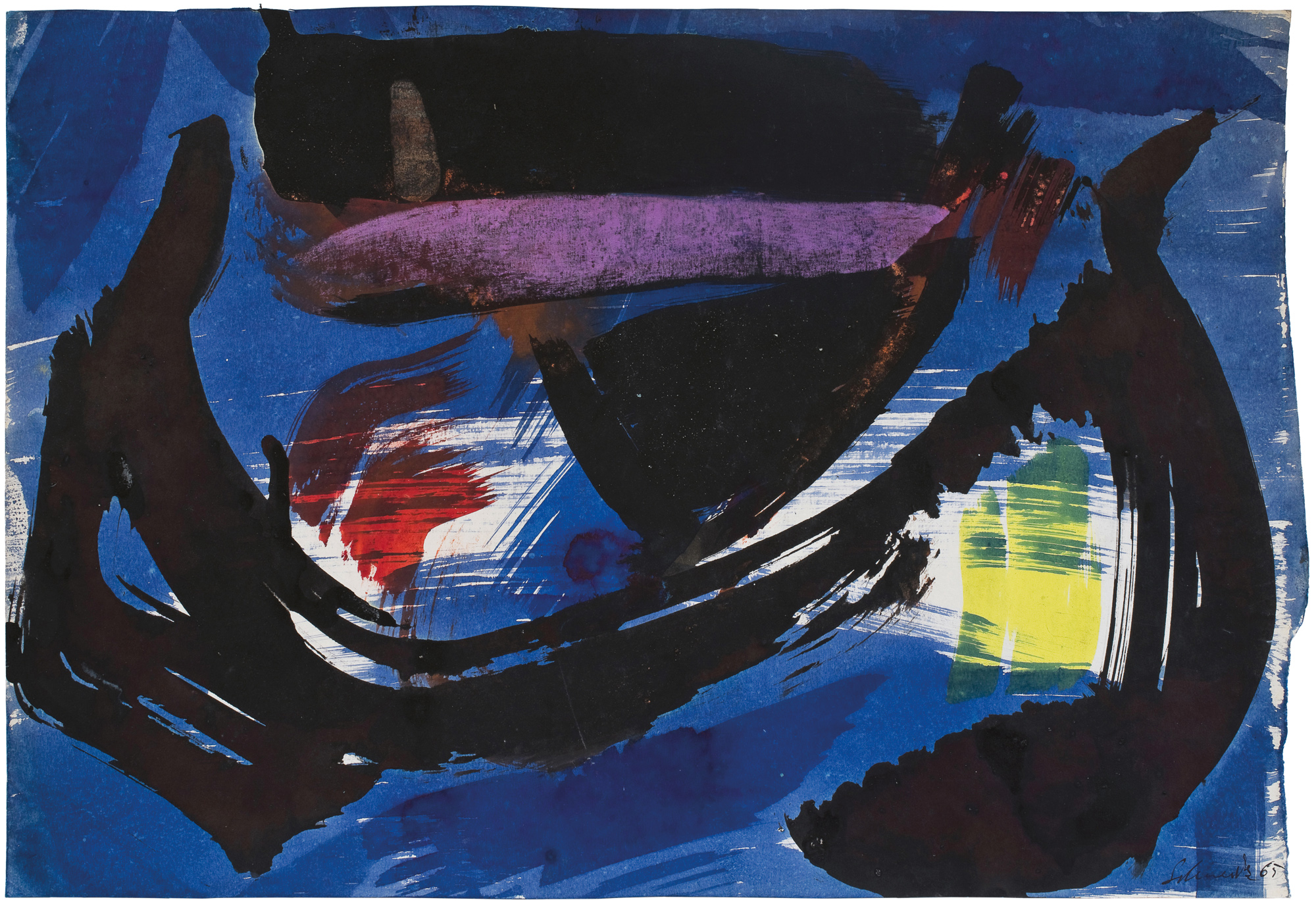
Gérard SCHNEIDER
Untitled – 1965
Gouache and India ink on paper mounted on cardboard
34,7 x 50,5 cm / 13 11/16 x 19 7/8 in.
Signed and dated “Schneider 65” lower right
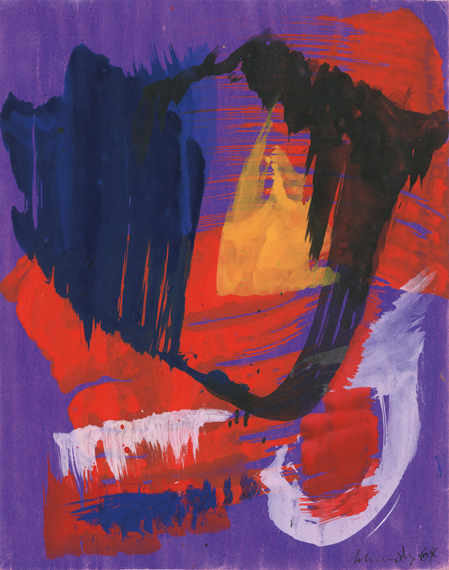
Gérard SCHNEIDER
Untitled – 1967
Gouache on paper
31,7 x 25 cm / 12 1/2 x 9 13/16 in.
Signed and dated “Schneider -67” lower right
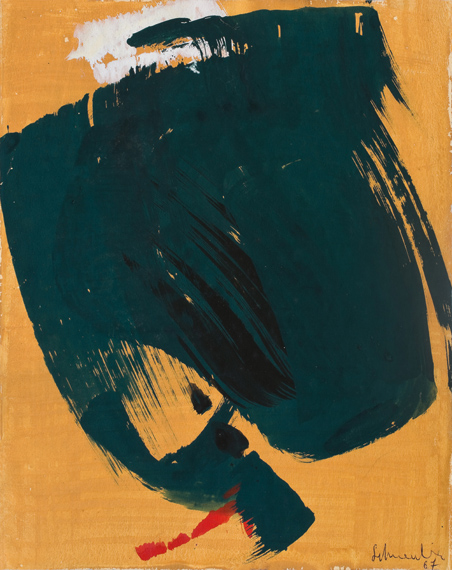
Gérard SCHNEIDER
Untitled – 1967
Gouache on paper
31,3 x 25 cm / 12 5/16 x 9 13/16 in.
Signed and dated “Schneider / 67” lower right

Gérard SCHNEIDER
Untitled – 1966
Gouache on paper mounted on cardboard
37,5 x 52,5 cm / 14 3/4 x 20 11/16 in.
Signed and dated “Schneider 66” lower right
“A painting is an organized whole, a set of relations between shapes, lines, coloured surfaces, to which the meanings that are given are found or lost.”
Gérard Schneider, in Entretiens sur l’Art abstrait, Pierre Cailler, 1964

Gérard SCHNEIDER
Untitled – 1967
Acrylic and oil on paper mounted on cardboard
38 x 46,2 cm / 14 15/16 x 18 3/16 in.
Signed and dated “Schneider 67” lower right

Gérard SCHNEIDER
Untitled – 1967
Acrylic and oil on paper mounted on cardboard
38,2 x 46,5 cm / 15 1/16 x 18 5/16 in.
Signed and dated “Schneider 67” lower right
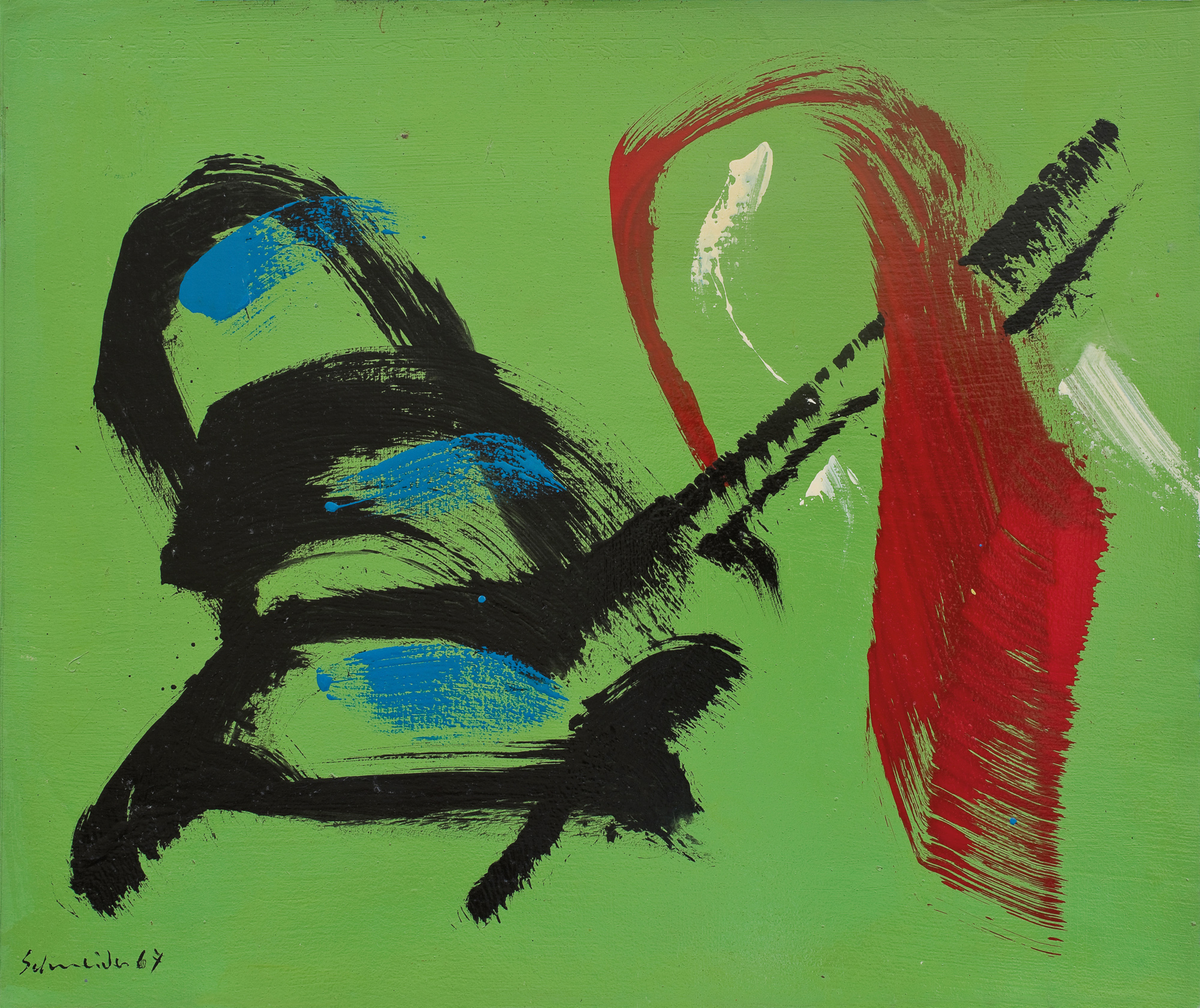
Gérard SCHNEIDER
Untitled – 1967
Acrylic and oil on paper mounted on cardboard
38,7 x 46,5 cm / 15 1/4 x 18 5/16 in.
Signed and dated “Schneider 67” lower left

repr. p. 33

repr. p. 35

repr. p. 37

repr. p. 36
In the second half of the 1960s, colour became a structuring element. It is an architectural component in Schneider’s work. The light no longer emanates from the background, but is evoked by the use of uniform colours, by the presence of complementary colours that echo the chromatic shock caused by the Fauves and its vibrations of colour. This was the period of Pop Art in the USA and of New Realism in France, the age of glory for advertising: strong and bright colours invaded the collective conscious.
From 1967-1968, Schneider began to use acrylic in his works, both on canvas and on paper, a new medium that he adopted definitively at the beginning of the 1970s. Because it dries quicker, acrylic allowed him to act fully in the spontaneity of the creative gesture. Contrary to his habit, Schneider built backgrounds in flat areas of colour so that only the colour would imprint on the retina. Purified paintings are the result, in which the gesture is gradually simplified, ultimately forming a structure in distinct shapes that respond to each other, recalling Matisse’s Papiers découpés from the end of his life. A new relationship between form and colour that was a prefiguration of the following decade.
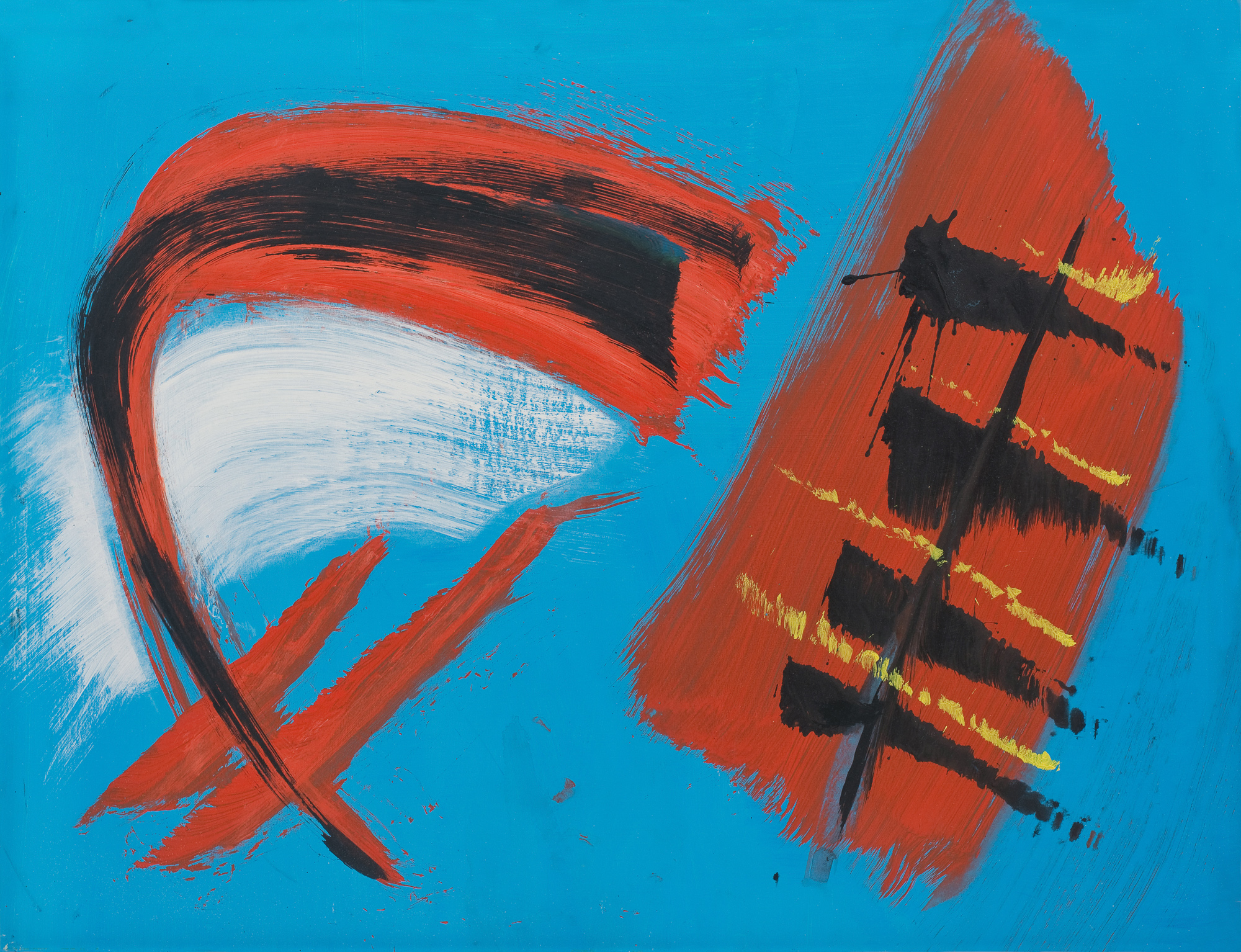
Gérard Schneider
Untitled, 1970 ca.
Acrylic on paper
laid on canvas, 50 x 65 cm

Gérard SCHNEIDER
Untitled – 1967
Acrylic and oil on paper mounted on cardboard
38,2 x 46,5 cm / 15 1/16 x 18 5/16 in.
Signed and dated “Schneider 67” lower left
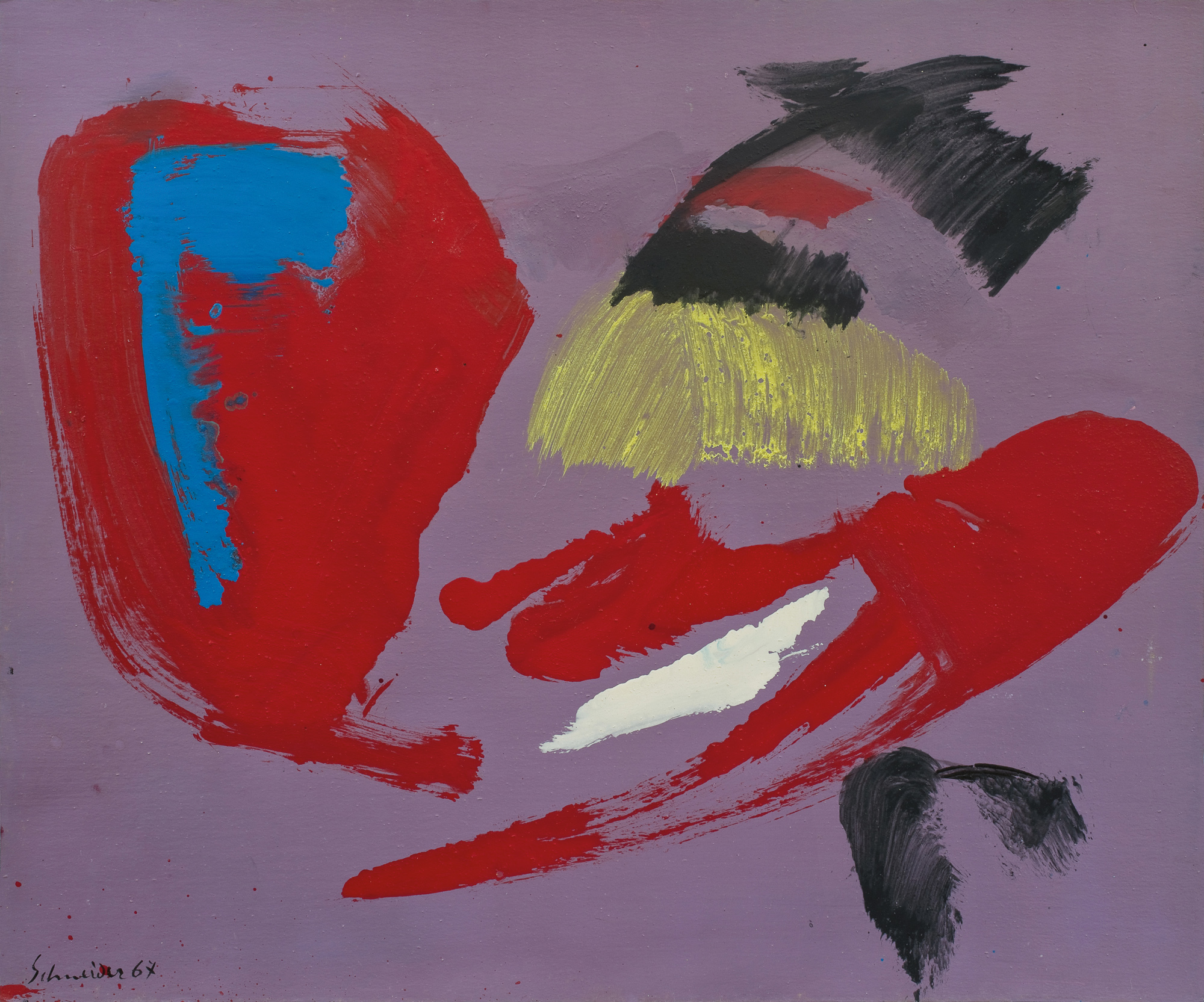
Gérard SCHNEIDER
Untitled – 1967
Acrylic and oil on paper mounted on cardboard
38 x 46 cm / 14 15/16 x 18 1/8 in.
Signed and dated “Schneider 67” lower left
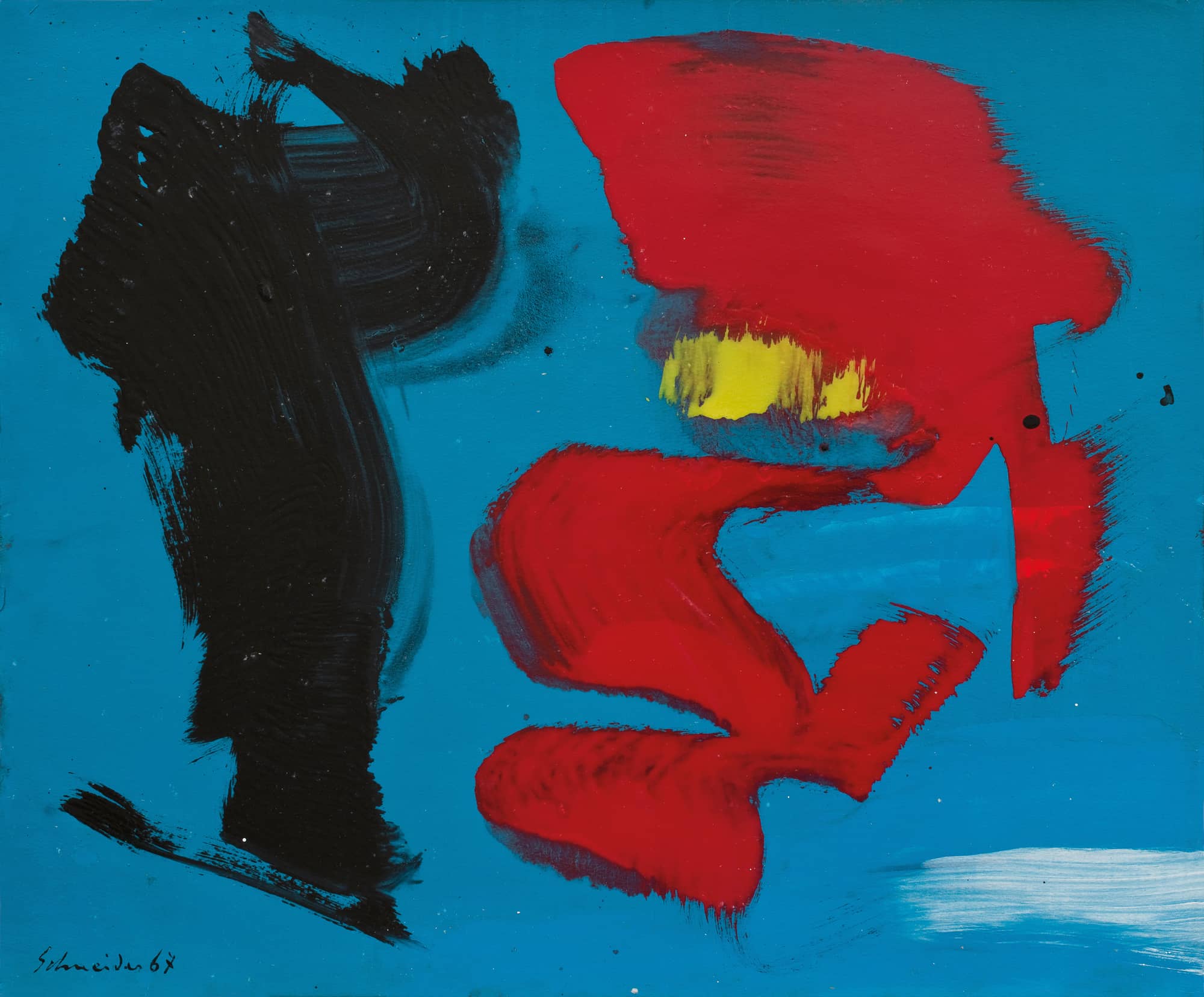
Gérard SCHNEIDER
Untitled – 1967
Acrylic and oil on paper mounted on cardboard
38 x 46,2 cm / 14 15/16 x 18 3/16 in.
Signed and dated ‘Schneider 67” lower left

Gérard SCHNEIDER
Untitled – 1967
Gouache and pastel on paper
21,5 x 32,2 cm / 8 7/16 x 12 11/16 in.
Signed and dated “Schneider.67” lower left
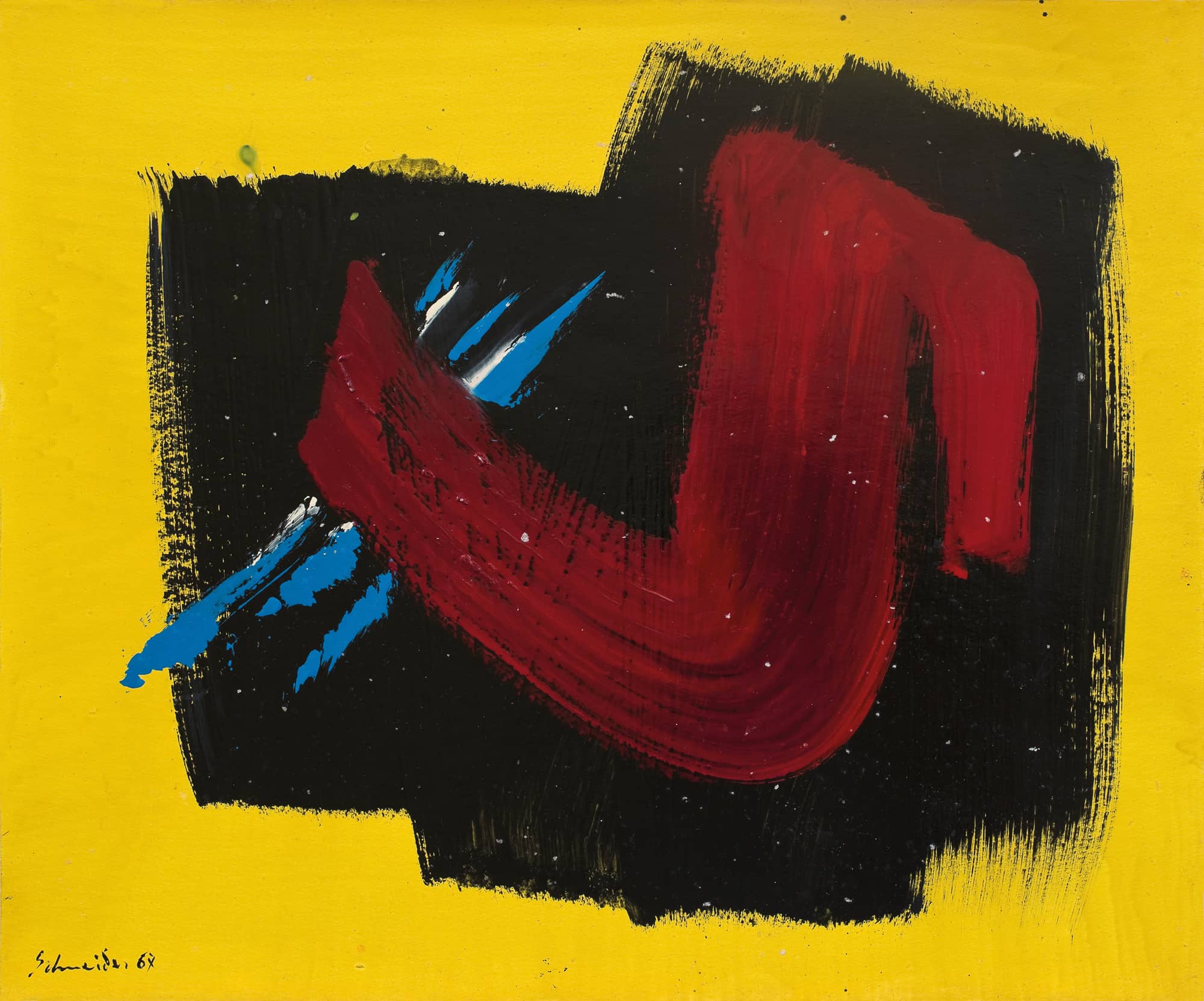
Gérard SCHNEIDER
Untitled – 1967
Acrylic and oil on paper mounted on cardboard
38 x 46 cm / 14 15/16 x 18 1/8 in.
Signed and dated “Schneider 67” lower left

Gérard SCHNEIDER
Untitled – 1967
Acrylic and oil on paper mounted on cardboard
38,6 x 46,5 cm / 15 3/16 x 18 5/16 in
Signed and dated “Schneider 67” lower right

Gérard SCHNEIDER
Untitled – 1967
Acrylic and oil on paper mounted on cardboard
38,4 x 46,4 cm / 15 1/8 x 18 1/4 in.
Signed and dated “Schneider 67” lower left
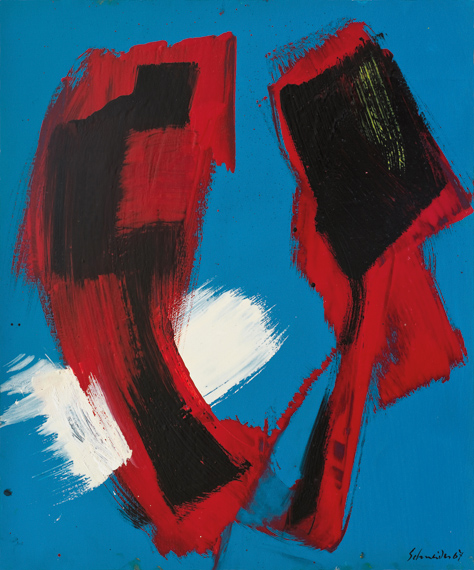
Gérard SCHNEIDER
Untitled – 1967
Acrylic and oil on paper mounted on cardboard
46 x 38 cm / 18 1/8 x 14 15/16 in.
Signed and dated “Schneider 67” lower right
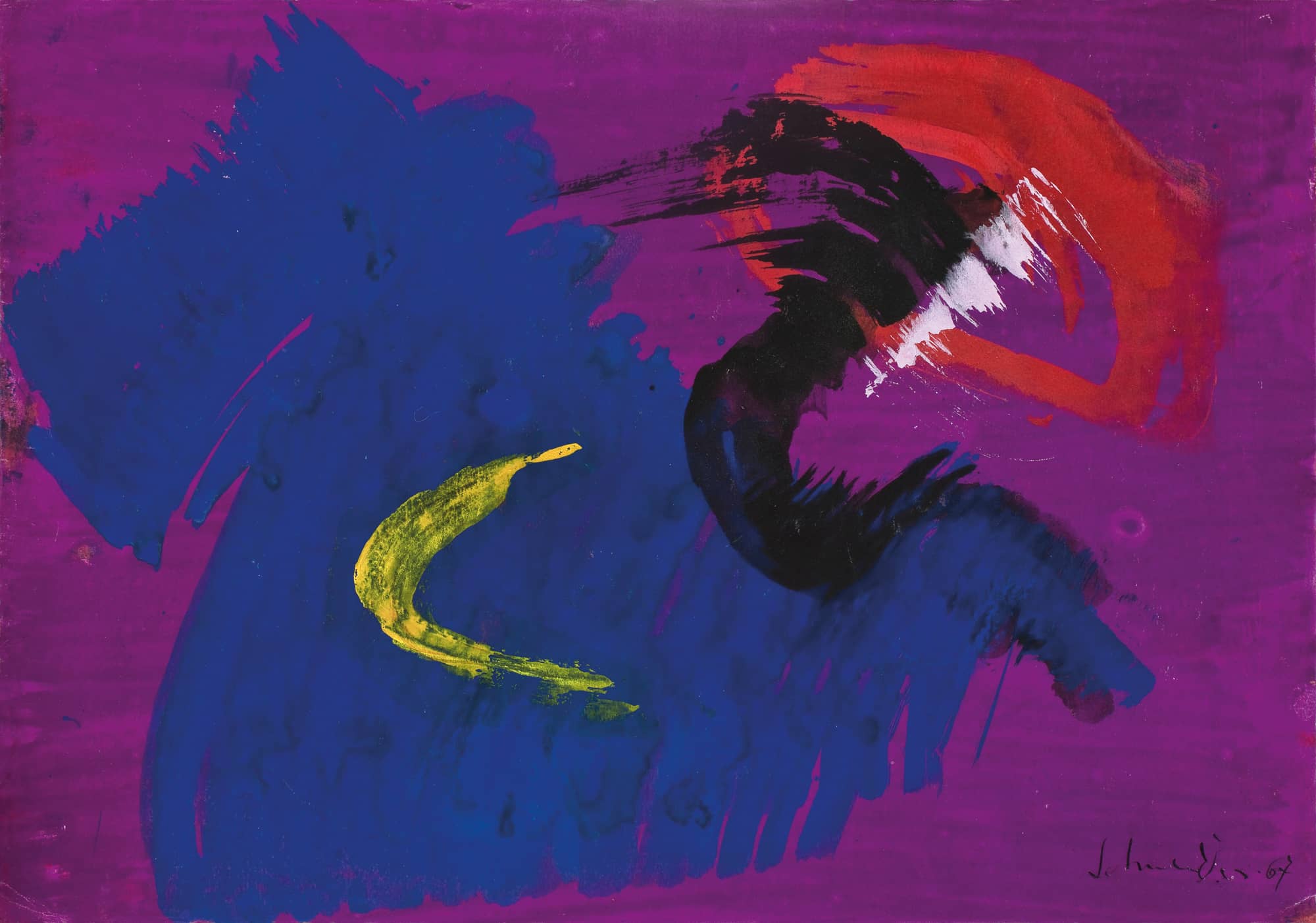
Gérard SCHNEIDER
Untitled – 1967
Gouache and India ink on paper
26,4 x 37,3 cm / 10 3/8 x 14 11/16 in
Signed and dated “Schneider – 67” lower right

Gérard SCHNEIDER
Untitled – 1968
Gouache on paper
31,4 x 25 cm / 12 3/8 x 9 13/16 in.
Signed and dated “Schneider-68” lower right
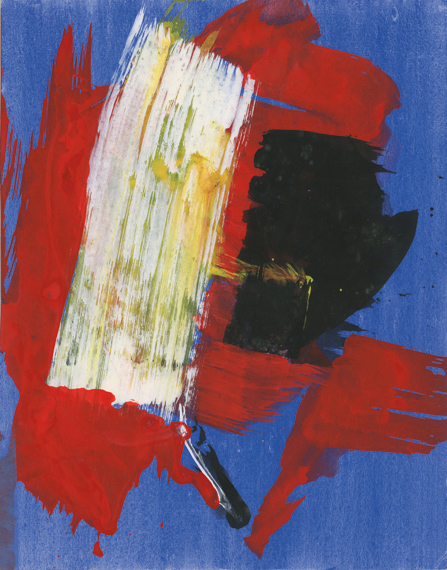
Gérard SCHNEIDER
Untitled – 1968 ca.
Gouache on paper
31,5 x 24,8 cm / 12 3/8 x 9 3/4 in.
Non signed, non dated

Gérard SCHNEIDER
Untitled – 1968
Acrylic and oil on paper mounted on cardboard
37,6 x 52,5 cm / 14 13/16 x 20 11/16 in.
Signed and dated “Schneider 68” lower left

Gérard SCHNEIDER
Untitled – 1968
Acrylic and pastel on paper
17,5 x 26,7 cm / 6 7/8 x 10 1/2 in.
Signed and dated “Schn / 68” lower left

Gérard SCHNEIDER
Untitled – 1968
Acrylic and oil on paper mounted on cardboard
28,9 x 47,5 cm / 11 3/8 x 18 11/16 in.
Signed and dated “Schneider 68” lower right

Gérard SCHNEIDER
Opus 30 i – 1968
Acrylic and oil on paper mounted on cardboard
38,5 x 55 cm / 15 3/16 x 21 5/8 in.
Signed and dated “Schneider – 68” lower left
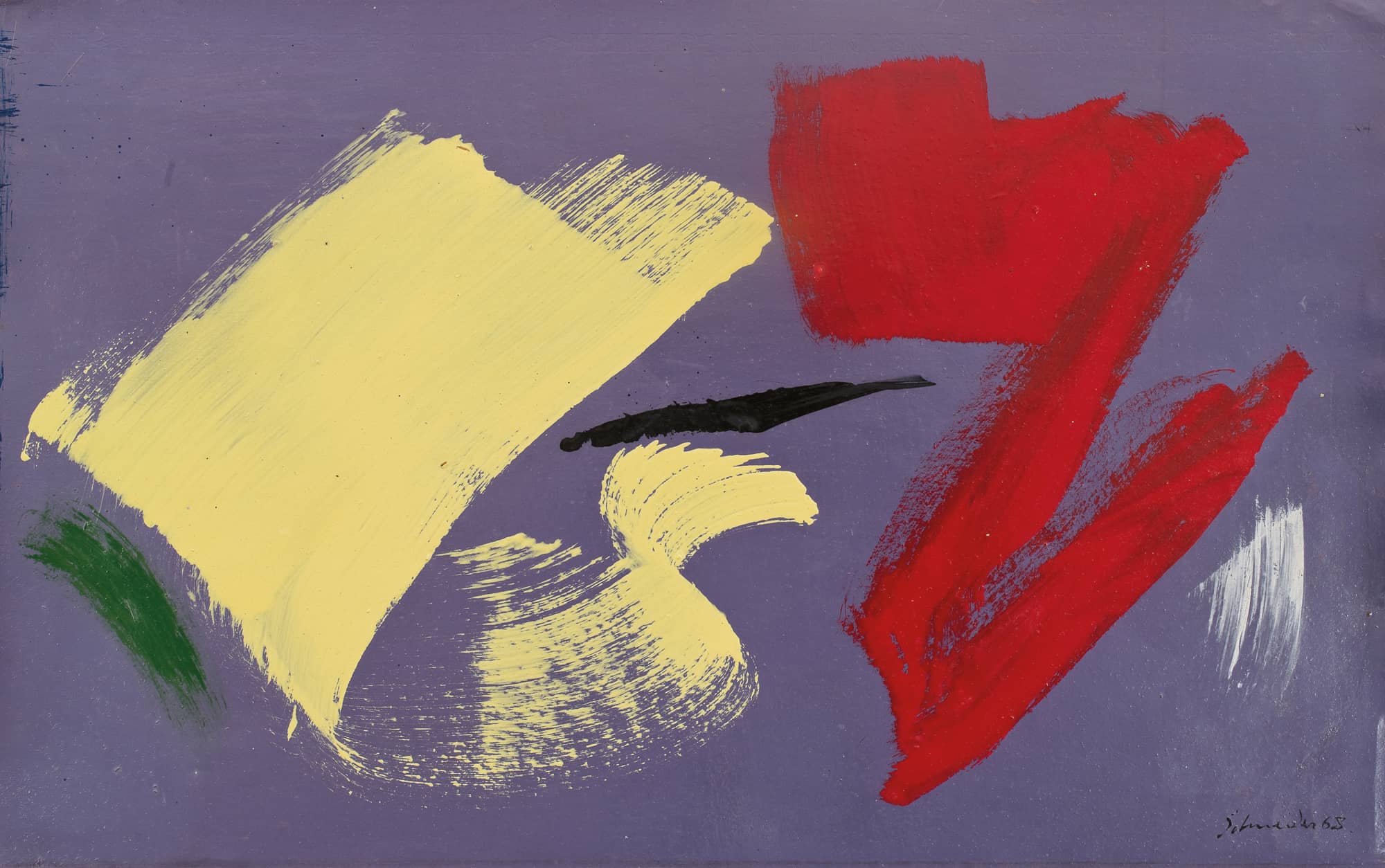
Gérard SCHNEIDER
Untitled – 1968
Acrylic and oil on paper mounted on cardboard
34,7 x 56,2 cm / 13 11/16 x 22 1/8 in.
Signed and dated “Schneider 68” lower right

Gérard SCHNEIDER
Untitled – 1968
Acrylic and oil on paper mounted on cardboard
38 x 46,3 cm / 14 15/16 x 18 1/4 in.
Signed and dated “Schneider 68” lower left
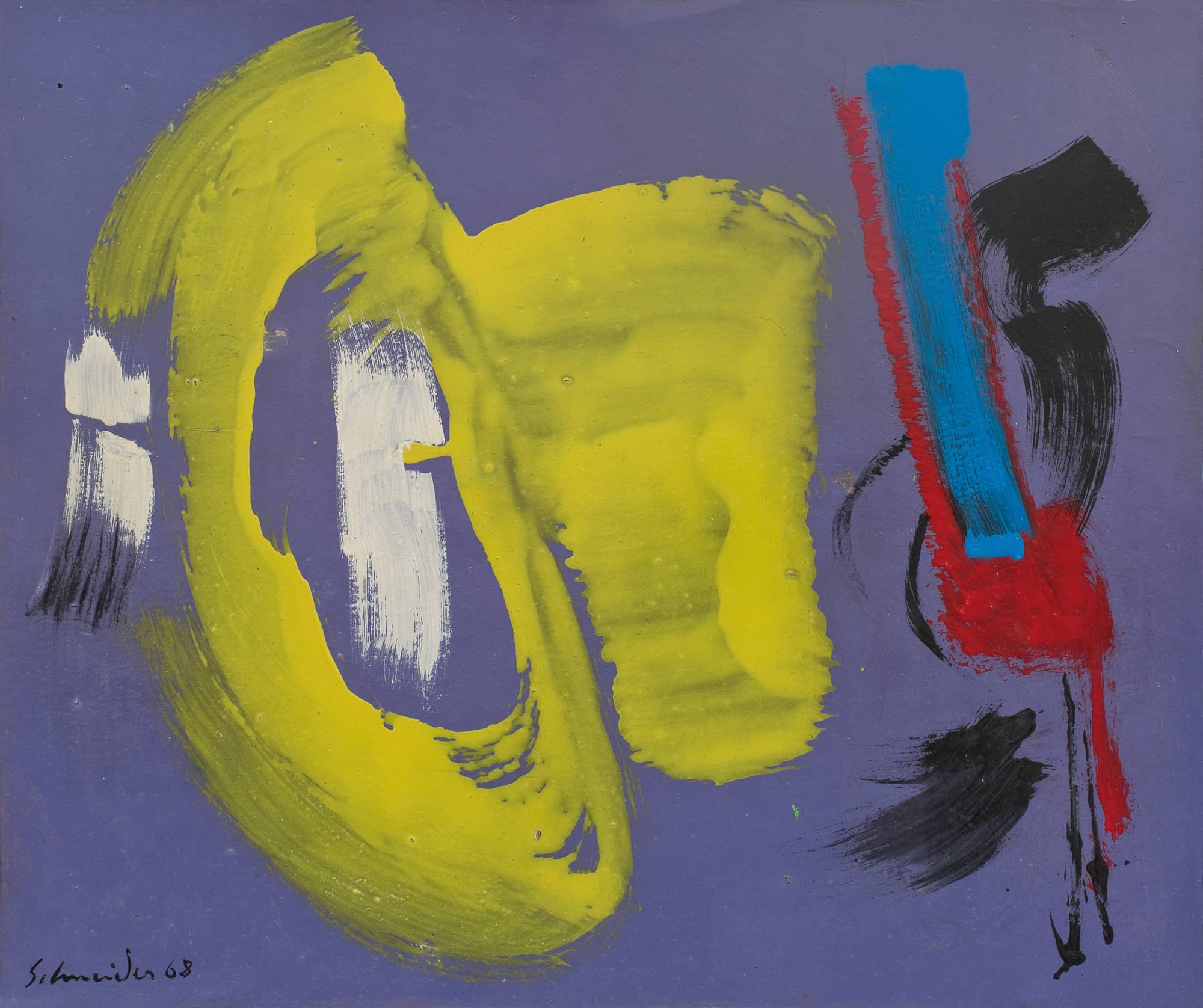
Gérard SCHNEIDER
Untitled – 1968
Acrylic and oil on paper mounted on cardboard
38,5 x 46,3 cm / 15 3/16 x 18 1/4 in.
Signed and dated “Schneider 68” lower left

APPENDICES
Major collections
Brussels, Musée Modern Museum
Buffalo, NY, Albright-Knox Art Gallery
Cologne, Musée Ludwig
Colorado Springs, Co, Fine Art Center
Dunkirk, LAAC
Geneva, Fondation Gandur pour l’Art
Grenoble, Musée de Grenoble
Jakarta, Museum
Kamakura (Japan), Museum of State
Los Angeles, Ca, University of California
Minneapolis, Mn, Walker Art Center
Nantes, Musée d’Arts
Neuchâtel (Switzerland), Musée d’Art et d’Histoire
New Haven, Ct, Yale University
New York, NY, Museum of Modern Art (MoMA)
Oslo, Sonja Henie and Niels Onstad Foundation
Paris, Musée d’Art Moderne de Paris
Paris, Musée national d’Art Moderne – Centre Pompidou
Phoenix, Az, Phoenix Museum
Princeton, Ma, Princeton University
Rio de Janeiro, Museu de Arta Moderna do Rio de Janeiro
Saint-Louis, Mo, Washington University
Seoul, Fine Art museum
Turin, Galleria civica d’Arte Moderna
Verviers (Belgium), Musée des Beaux-Arts et de la Céramique
Washington D.C., The Phillips Collection
Worchester, Ma, Worchester Museum
Zurich, Kunsthaus
MAJOR EXHIBITIONS
Galerie Denise René, Paris, 1946, 1947, 1948, 1953
Galerie Lydia Conti, Paris, 1947, 1948, 1950
Venice Biennale, 1948, 1954, 1966
Wanderausstellung Französischer Abstrakter Malerei, travelling group show in West Germany: Stuttgart, Munich, Düsseldorf, Hanover, Hamburg, Frankfurt am Main, Freiburg im Breisgau, 1948-1949
Betty Parsons Gallery, New York, 1949, 1951
Les grands courants de la peinture contemporaine (de Manet à nos jours), travelling group show in South America, 1949-1950
Advancing French Art, travelling group show in United States of America: Louisville, Bloomington, San Francisco, Chicago and Washington, 1951-1952
São Paulo Biennale, 1951, 1954, 1961
Der Spiegel Gallery, Cologne, 1952, 1953, 1955, 1957, 1981
Otto Stangl Gallery, Munich, 1952
International Art Exhibition, travelling group show in Japan, 1953-1965
Gérard Schneider, retrospective, Palais des Beaux-Arts, Brussels, 1953
Galerie Arnaud, Paris, 1954, 1959, 1965, 1967, 1968, 1970
Documenta in Kassel, 1955, 1959
Kootz Gallery, New York, 1956-1961
Galerie Apollinaire, Milan, 1958
Albright-Knox Art Gallery, Buffalo, NY, 1958, 1959, 1966, 1972
Lorenzelli Gallery, Milan, 1960, 1961, 1965, 1972, 1974, 1986, 1989, 2012
Minami Gallery, Tokyo, 1960
Nakanoshima Gallery, Osaka, 1960
Im Erker Gallery, Saint-Gall, 1961, 1963
Salon de Mai in Japan, Tokyo, Osaka, 1962
Gérard Schneider, retrospective, travelling exhibition: Kunstverein, Düsseldorf / Palais des Beaux-Arts, Brussels, 1962
Paintings in France 1900-1967, travelling group show in United States of America: New York, Boston, Chicago, San Francisco and in Canada, 1968
Gérard Schneider, retrospective, Galleria civica d’Arte moderna, Turin, 1970
Pavillon Terre des Hommes, Montreal, 1970
Panorama de l’Art contemporain, travelling group show in Iran, Egypt, Greece, Turkey, Syria, Morocco, Algeria, Tunisia, Lebanon, 1971-1972
Galerie Beaubourg, Paris, 1974, 1975, 1977, 1981, 1986
Gérard Schneider, retrospective, Musée d’Art et d’Histoire, Neuchâtel (Switzerland) / Musée d’Art Contemporain, Dunkerque (France), 1983
FIAC, Galerie Patrice Trigano, Paris, 1983
Kunstmesse, Basel, 1985
L’Europe des grands maîtres, Musée Jacquemart-André, Paris / Musée des beaux-arts, Seoul, 1989
Schneider, rétrospective, travelling retrospective in France: Clermont-Ferrand, Carcassonne, Montbéliard, Le Mans, Metz, 1998-2001
L’Envolée lyrique, Paris 1945-1956, Musée du Luxembourg, Paris, 2006
Gérard Schneider, grands gestes pour un grand monde, Musée d’Art & d’Histoire, Neuchâtel (Switzerland), 2011
Montparnasse / Saint-Germain-des-Prés, Angers / Bordeaux, 2012
Les Sujets de l’abstraction, Peinture non-figurative de la Seconde École de Paris (1946-1962), group show, Fondation Gandur pour l’Art, Musée Rath, Geneva / Musée Fabre, Montpellier, 2011
Gérard Schneider, rétrospective, Musée des Beaux-Arts d’Orléans, 2013
Le Geste et la Matière – Une abstraction « autre » – Paris, 1945-1965,
Fondation Clément, Le François, Martinique, 2017
SELECTED BIBLIOGRAPHY
Marcel Pobé, Schneider, Paris: Georges Fall, 1959
Michel Ragon, Schneider, Amriswill: Bodensee Verlag, 1961
Marcel Brion, R. V. Gindertael, Schneider, Venice: Alfieri, 1967
Gérard Schneider, exhibition catalog, Turin, Galleria civica d’Arte moderna (16 April–24 May 1970), Turin: Galleria civica d’Arte moderna, 1970
Gérard Schneider, Eugène Ionesco (foreword), Mots au vol, Paris: Éditions Saint-Germain-des-Prés, 1974
Pierre von Allmen (dir.), Jean-Marie Dunoyer, Schneider, exhibition catalog, Neuchâtel, Musée d’Art et d’Histoire (26 February–17 April 1983), Neuchâtel: Musée d’Art et d’Histoire de Neuchâtel, 1983
Jean Orizet, Schneider Peintures, Paris: La différence / L’autre musée, 1984
Daniel Chabrissoux, Loïs Frederick, Gérard Schneider : œuvres de 1916 à 1986,
exhibition catalog, Angers, (1991), Angers: Expressions contemporaines, 1991
Michel Ragon, Schneider, Angers: Expressions contemporaines, 1998
Patrick-Gilles Persin, L’Envolée lyrique Paris 1945-1956, exhibition catalog, Paris, Musée du Luxembourg (26 April–6 August 2006), Milan: Skira, 2006
Éric de Chassey (dir.), Éveline Notter (dir.), Justine Moeckli et al., Les sujets de l’abstraction. Peinture non-figurative de la seconde École de Paris, 1946-1962.
101 Chefs-d’œuvre de la Fondation Gandur pour l’Art, exhibition catalog, Geneva, Musée Rath (6 May–14 August 2011) / Montpellier, Musée Fabre (3 December 2011–25 March 2012), Milan: 5 continents, 2011
Christian Briend, Nathalie Ernoult, Le Geste et la Matière – Une abstraction «autre » – Paris, 1945-1965, exhibition catalog, Le François, Martinique, Fondation Clément (22 January–16 April 2017), Paris / Le François: Centre Pompidou / Fondation Clément / Somogy éditions d’Art, 2017
Crédits photo – photo credits
1, 2, 4, 5, 7, 11, 13, 15, 16 – Droits réservés / Archives Gérard Schneider – Adagp, Paris
3 – Droits réservés
6, 14, 17 – Droits réservés / Archives Gérard Schneider
8 – Droits réservés / Galerie San Fedele, Milan – Adagp, Paris
9 – Droits réservés / GAM, Turin – Adagp, Paris
10 – Michel Ragon / Archives Gérard Schneider
11 – Droits réservés / Galerie Lorenzelli, Milan
